#_author:David Pogue
Text
Review of battle-royale game 'Player Unknown: Battlegrounds' — this week's No. 1 app
yahoo
Welcome to David Pogue’s Rated:App series. Each week, I install whatever is the No. 1 bestselling app on the iOS or Android store and review it, to save you the effort in case it’s a turkey!
This week, the No. 1 most downloaded app on Android store, and No. 2 on iPhone, is a game called Player Unknown: Battlegrounds, better known as PUBG.
Why is it No. 1? Because it’s free, because it just came out for phones, and because it’s already crazy popular. Its PC/console versions made PUBG the most-played new video game of 2017.

In PUBG, you explore the island, looking for people to kill.
Meet the battle royale
PUBG is a “battle royale” game, meaning that it’s a military-style, free-for-all, fight to the death. It’s extremely similar to its arch-rival, Fortnite: Battle Royale (which is also free, and is currently neck-and-neck with PUBG on the iOS app store [not available yet for Android]).
At the very start of the game (after choosing the look, gender, race, and screen name for your avatar), you’re in sort of a limbo where you can run around, practice punching and crouching, waiting for 100 players from the internet to accumulate. Once they do, the action cuts to a plane flying high above an island. You choose when to jump out, at which point you skydive, and eventually pop your parachute.

Geronimo! You can control your direction as you skydive.
You explore this island by running around (the “camera” is always behind you) or hopping onto rusty old cars, tanks, or motorcycles. As you go, you find and pick up weapons, protective gear, medical kits, and energy drinks. But be wise: You can carry only so much weight — and you can hold only two guns at a time.
If you’re in Squad mode, getting shot by the enemy doesn’t necessarily mean Game Over. You’re just wounded at first, and your teammates can help you back to your feet.
As time goes by, the playing area slowly contracts, forcing players into a tighter space and heightening the action. The walls, in the form of a creepy blue shimmering bubble, slowly close in on you; if you’re caught inside it, you lose Health.

Beware the shimmering blue dome. It’s closing in, forcing players into tighter proximity.
Oh yeah — it’s also best to avoid the Red Zone: an occasional region of bombardment that will get you killed if you’re not inside a building.
Your objective, of course, is to kill people by shooting them. If you (or your team) are the last alive, you earn the famous “winner winner chicken dinner” screen.

Hey! You won!
Now, depending on your age and temperament, you may be slightly aghast to learn that the most popular phone app in the world encourages the brutal killing of total strangers. As a parent, even I caught my breath to see YouTube videos of PUBGers in action.
On the other hand, if we’re going to start objecting to violent video games, we’ve got a much bigger problem than this little app.

Approaching an injured enemy to finish him off and take his ammo.
The PUBG controversy
One nice thing about PUBG is that even your first time out, you can have some success. You might even get yourself some chicken dinner.
Don’t get too cocky, though. At the beginning levels, many of your enemies are just clumsy, slow bots, put there by the software company to give you something to shoot at. As a novice, I found that to be a clever and welcome idea, but experienced gamers are mightily annoyed at what feels like patronizing, sissy training wheels and manufactured popularity.
But there’s a larger controversy surrounding PUBG Mobile: Lots of people are running this app on their PCs (in a phone emulator) or on a Chromebook (an Android laptop). That way, they can avoid paying $30 for the actual PC version of the game. And that way, use their keyboard and mouse, which gives them a huge speed and control advantage over the poor slobs whose only controls are the phone’s touch screen.
There’s no solution in sight. And plenty of gaming pundits think that this “PUBG on the PC” problem might ultimately ruin the game.
But how is it?
PUBG’s graphics and sound are really good (they scale to the abilities of your phone); if you listen with earbuds on, the sounds actually clue you in to the location of enemy fire. (There’s an on-screen directional indicator, too.) The controls are generally about as good as you can find on a phone touchscreen, although many PUBG’ers complain that they fire their guns accidentally — the “shoot” button is right in the path of the thumb you use to look around you.

If you find a vehicle, you can make better time exploring the island.
If a military-style battle royale sounds like your kind of gig, you’ll find a lot of satisfaction in PUBG. It requires both luck and skill; it gives everyone a shot at the poultry meal; it raises your heart rate and, at times, makes you crack up. Just try to avoid mashing your thumbs all the way through your screen.
David Pogue, tech columnist for Yahoo Finance, welcomes non-toxic comments in the Comments below. On the Web, he’s davidpogue.com. On Twitter, he’s @pogue. On email, he’s [email protected]. You can sign up to get his stuff by email, here.
Read more
Review of this week’s No. 1 app: Human Anatomy Atlas 2018
Pogue reviews this week’s No. 1 most downloaded app: Sky Guide AR
The controversial Vero is this week’s David Pogue’s Rated:App
Bitmoji is this week’s David Pogue’s Rated:App
This week’s David Pogue’s Rated:App is on Facetune
#tech#Pogue#_lmsid:a077000000BAh3wAAD#_uuid:ae56277b-53f2-3290-ac8d-30c0917e5899#_revsp:yahoofinance.com#_author:David Pogue
9 notes
·
View notes
Text
The Fitbit Versa smartwatch is small, cheap and sweet
It’s tough being a fitness-tracker maker. Nike, Jawbone, and Microsoft all abandoned the market entirely. Fitbit soldiers on, but it hasn’t been easy.
It’s not that people have stopped caring about their health. It’s that little by little, smartwatches have been eating fitness bands’ lunch. So Fitbit Inc. (FIT) figured: “Well, we better make a smartwatch then!”
The first attempt, last year’s Fitbit Ionic, was a dud. It was huge. It looked like you were wearing a car door on your wrist. And it cost $300, almost as much as an Apple Watch did at the time.
Well, good news all around: Fitbit has brought forth a second smartwatch. It’s called the Versa, and it takes a sledgehammer to everything that was wrong with the Ionic.

The Fitbit Versa falls exactly halfway between fitness wristbands and full-blown wrist computers like the Apple Watch.
Size and shape
The Versa costs $200 instead of $300. Nicely done, Fitbit. (The Apple Watch 3 starts at $330 and goes up to $750.)
And instead of being big, homely, angular and wrapping halfway around your wrist, the Versa is small, sweet and unbelievably light, even though it’s made of metal (aluminum).

The 1.34-inch screen is square; the body is rounded.
The Versa is smaller and thinner than the Apple Watch. It’s slightly wider, but that’s fine — it makes much more sense to expand along the direction that your arm goes, rather than trying to be a flat object on your curved wrist.
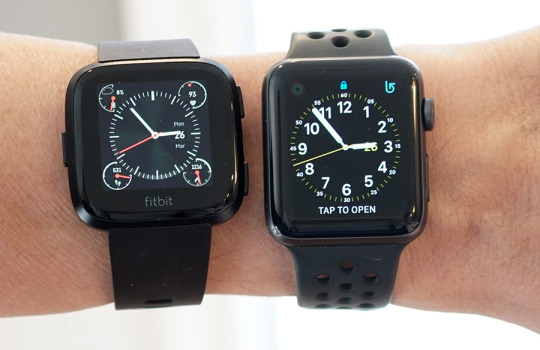
The Versa (left) is slightly wider, but shorter, than the 42mm Apple Watch.
Small is huge. Small means less obtrusive. Small means better suited for many women.
And small means stylish. You can get the Versa in black, silver, or peach aluminum; a “special edition” costs $30 more and comes in dark gray or rose gold. All of them look great, and you can make them look even greater by replacing the included silicone band with a leather, cloth, metal- mesh, or metal-links band.
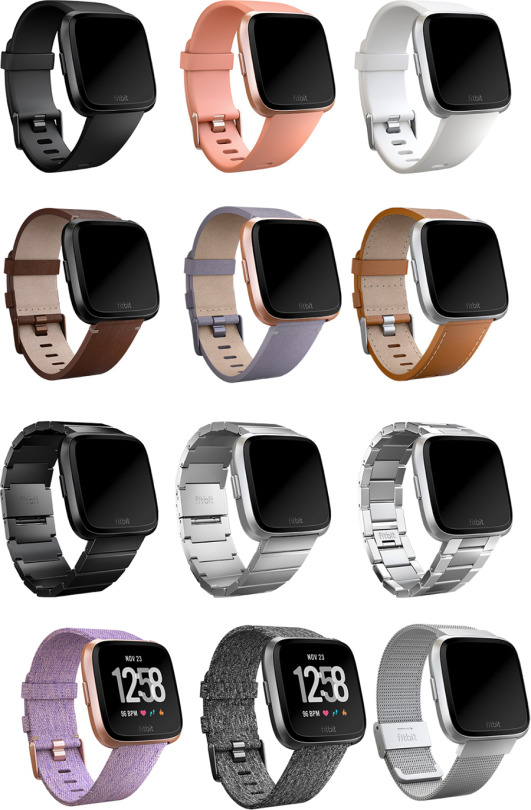
Here’s a sampling of some of the silicone, leather, cloth, and metal bands available.
You can swap bands without tools, although it takes practice. Even after 20 minutes, I never could get the leather band to go on.

Swapping bands involves fiddling with the spring-loaded release lever.
And here’s the truly great part: Fitibt says it goes “four-plus days” on a charge, but it always under advertises battery life. My review unit is happily ticking away on Day Six. Take that, Apple Watch, which you have to charge every single night (and therefore can’t use to track your sleep)!

You charge the Versa by snapping it into a new, spring-loaded stand.
You do, however, sacrifice something for the cheaper price and smaller size: built-in GPS. The Ionic has it, the Versa doesn’t. If you want to map your runs or rides, you have to take your phone with you; the Versa’s software grabs its GPS information from the phone itself.
On the U.S. base model, you also lose Fitbit Pay, which lets you pay for things with your wrist at wireless terminals. Alas, the list of recognizable participating banks are still limited — American Express, Bank of America, Capital One, Wells Fargo, and U.S. Bank. Chase is coming soon. If your credit card comes from one of those banks, and you care about this feature, it’s available for an additional $30 on the Special Edition.

The Fitbit Versa (right) lacks the Apple Watch’s weird bulge on the bottom.
The features
The Versa’s features are mostly identical to the Ionic watch’s, although the new operating system (coming to the Ionic later this year) greatly simplifies navigation.
The Versa has water resistance down to 50 meters, swim tracking and lap counting, 2.5 gigabytes for storing music to play (over wireless earbuds), and auto-recognition of 20 different exercises. It offers guided breathing sessions when you need to relax, and optional hourly reminders to get up and move around.
When it comes to tracking your health, the Versa is a champ. It tallies your steps, calories, and distance; flights of stairs you’ve taken; minutes of exertion; continuous heart rate; and your stages of sleep, which is remarkably accurate and informative.

The touchscreen is square and colorful and very bright.
Underneath, the heart-rate sensor has a third LED light, capable of detecting how much blood oxygen you’ve got (your relative SPO2). Someday, that statistic could provide early detection for conditions like atrial fibrillation or sleep apnea, which would be a huge deal for millions of people.
(Personal sob story: My favorite Fitbit is the incredibly slim, small Fitbit Alta. It does a great job of tracking my stats, including heart rate, during the day and night. But when a foot injury drove me to switch from jogging to stationary biking, I discovered, like many others, that the Alta wouldn’t record my heart rate during exercise! It either dramatically under-reported my pulse rate, or didn’t pick up a pulse at all.
Online, many people with that problem solved it by switching to the fatter Fitbit Charge 2 band. For me, that band did much better — but still sometimes underreported compared to a Polar chest strap. I’m happy to report that the Versa’s heart-rate monitor is dead on during exercise —within a beat or two of the chest-strap’s measurement. Every time.)
You can pay $40 a year to use Fitbit Coach: guided video workouts that play on the Fitbit website or on your smartphone. (They don’t play on the watch itself, although audio-only guidance is available.) There’s a huge variety of duration and intensity, no equipment is required, and Fitbit says that the workouts adjust their intensity based on your own feedback.
Versa the smartwatch
Is the Versa, in fact, a smartwatch at all? I guess it depends on how you define that term. Smartwatches from companies like Apple and Samsung usually offer features like these:
Choice of watch faces. Maybe you like digital, or analog, or elegant, or complicated. The Versa’s app store now offers dozens of faces. Unfortunately, you have to choose them from the phone app (not on the watch) — and making a new selection involves a very slow Bluetooth transfer.

Plenty of watch faces await.
Notifications. Smartwatches can notify you on your wrist whenever one of your phone apps is trying to get your attention (you choose which apps). That’s especially useful when incoming calls and texts arrive. On the Versa, you can’t freely reply or take a call, as you can on the Apple Watch. In May, you’ll be able to respond with canned shortcut responses, but only on Android phones (not iPhones).
Music. You can load about 300 songs onto the Ionic, for playback through Bluetooth wireless earbuds when you’re working out. But you must load them from your computer using a crude Mac or Windows app called Fitbit Connect; it shows only playlists, not songs or albums. There are also Pandora and Deezer apps, but they require a paid subscription. There’s no Spotify.
Voice assistants. On real smartwatches, you can speak to Siri or the Google Assistant, and hear spoken replies. The Ionic has no speaker or microphone, so it can’t do any of that.
An app store. Fitbit’s smartwatch app store has finally begun to pick up steam. There are now about 500 apps available to install on your Versa, including Starbucks, Strava, New York Times, Weather, and so on. They’re all fairly slow and very simple.
Still to come
Fitbit is working hard to make the Versa attractive to women. Starting in May, you’ll be able to record every detail of your menstrual cycle in the Fitbit app — intensity, symptoms, and, of course, dates. Thereafter, it will display a calendar depicting your predicted period week in pink, and fertility window in blue.
Plenty of phone apps do exactly this, but having it part of the Fitbit app makes a lot of sense, because it’s tied in to all your other health stats. Eventually, the company plans to incorporate this other data (heart rate, for example) into its calculations, for even better accuracy.
A semi-smartwatch
To be clear, the Versa is not a smartwatch in the Apple Watch or Samsung Gear sense. It’s not a premium piece of jewelry that runs incredibly fast, runs thousands of apps, has a voice assistant, lets you respond to calls and texts, offers magnetic charging, have its own cellular connection, and so on.
But the Versa’s specs — five-day battery life, a $200 price tag, and small, sweet looks — define a worthy category unto itself. You’ll really like this thing.
David Pogue, tech columnist for Yahoo Finance, welcomes non-toxic comments in the Comments below. On the Web, he’s davidpogue.com. On Twitter, he’s @pogue. On email, he’s [email protected]. You can sign up to get his stuff by email, here.
Read more
Exclusive: What Fitbit’s 6 billion nights of sleep data reveals about us
Google Clips uses AI to snap pictures of your kids and pets — sort of
Why I bought Honda’s plug-in hybrid mystery car
Look up! A dozen ‘air taxi’ flying cars are readying for takeoff
#smartwatch#tech#Pogue#_lmsid:a077000000BAh3wAAD#_revsp:yahoofinance.com#$AAPL#_uuid:a82cc47d-a86f-315a-a849-b66b7b470af8#$FIT#Fitbit#_author:David Pogue
5 notes
·
View notes
Text
VICTOR sums up the trends that dominated CES 2018
yahoo
For normal people, the end of the year is a time for celebration, vacation, and family.
For people in the tech industry, though, it’s a time of frantic preparation for the biggest trade show in the Western Hemisphere: CES.
The Consumer Electronics Show takes place in Las Vegas every January, perfectly timed to drain the joy out of the holidays for 170,000 people. It’s not open to the public — only to members of the industry and the media that covers it.

The Consumer Electronics Show comes once a year, whether we like it or not.
The purpose of the show is for nearly 4,000 companies to show off what they’re working on. When will these products reach stores shelves? Some of it soon, some of it next year, and lots of it, never.
Every year, everyone wants to know: What was new at CES? The world is hungry for an exciting answer, like, “Oh, there’s this thing called an iPad!” or “They showed this car called a Tesla!”
But every year, there are fewer new breakout inventions; at CES 2018 last week, I’d say there were zero. (In fact, the most talked-about display at CES last week was when the power went out for two hours. At an electronics show. #irony.)
Instead, CES these days is more about the same buzzword, technologies seep into existing products from across the industry, cross fertilizing. This year, six of these seeping technologies were on display — which, for your convenience, I’ve boiled down to a handy acronym: VICTOR.
It stands for voice, Internet of Things, cars, TVs, oddballs, and robots.
Voice
At this point, you probably know that the Amazon Echo is that cylinder that sits in your house and responds to voice commands, kind of like Siri for the home. Google has its own copycat version, called Google Home. These things are incredibly popular — already, they’re in 16% of American homes.
Both Amazon and Google have been aggressively encouraging other companies to build their voice technologies into their own appliances: refrigerators, light switches, lamps, speakers, robo-vacuums, TVs, headphones, security cameras, door locks, washers, dryers, cars, and so on. “Works with Amazon Alexa!” and “Works with OK Google!” signs were everywhere at CES last week.
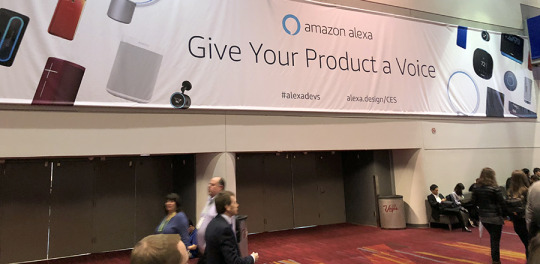
You couldn’t swing a cat without hitting an Alexa-enabled product.
What’s great is that this isn’t an either/or thing. It’s not another Betamax/VHS war, or a Blu-ray/HD-DVD war. Since Alexa and “OK Google” are just software, there’s nothing to stop them from coexisting in the same product. The Sonos One speaker, Vivitar smart speaker, and new TiVo models, for example, can all understand commands barked in either command language.
Internet of Things
The Internet of Things, of course, is the nonsensical name for home devices that are networkable, so that we can control them by pulling out our phones and opening an app. For something that’s supposed to make our lives simpler and easier, that’s too much hassle. Consumers have been staying away in droves.
What may save the “I” in VICTOR is the “V” in VICTOR — voice control. “Alexa, is the dryer done yet?” “Hey Google, make it two degrees warmer in here.” “Alexa, lock the doors.” “OK Google, I want to watch ‘Rambo.’”
That arrangement actually works — and was everywhere at CES 2018. Samsung and LG, among others, demonstrated entire model living rooms and kitchens filled with appliances waiting for your verbal command.

An LG employee shows how its new fridge has six cameras inside that let you see its contents.
Cars
The self-driving car courses at CES were a third bigger than last year. Every car company you’ve ever heard of, and a few you haven’t, were demonstrating their self-driving prototypes. Lyft was even giving a few lucky showgoers rides around town in self-driving cars.
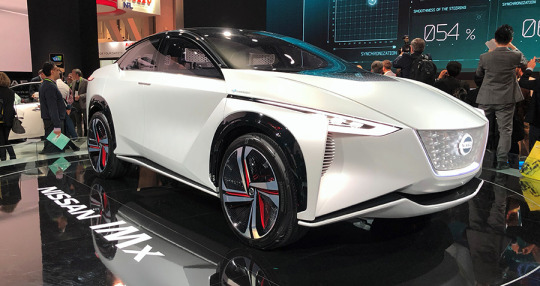
Sleek-looking concept cars filled the CES exhibit halls.
For 10 years, people have been saying that these cars would hit the roads in 2020 — and guess what? Unlike most heavily hyped new technologies, this horizon isn’t receding. People are still saying 2020. That means it’s probably real.
Lots of people were also talking about Toyota’s e-Palette, a prototype self-driving store.
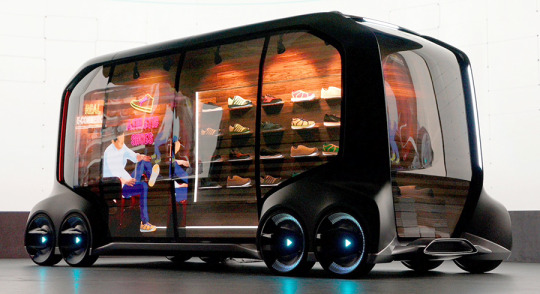
Toyota envisions its E-Palette as a self-driving store, delivery van, or even hotel room.
TVs
CES show floors have always been dominated by massive walls of brilliant TV screens, and this year was no exception. The industry is still hard at work pushing us to buy 4K TV screens, which have four times the number of pixels as hi-def screens. Only one problem: You can’t see the difference from a normal seating distance.

As it does every year, LG created a dazzling wall of TV screens—this time, in an undulating canyon.
Even if you could see it, there’s very little to watch. Not a single TV network or cable channel broadcasts in 4K. If you own a 4K television, and you want to watch 4K shows and movies, you have two choices: Buy a 4K Blu-ray player and buy new movies on disc — or stream your shows online, from services like Netflix, Amazon, Hulu, iTunes, Google Play, Vudu, and YouTube.
In short, 4K is kind of a hoax.
(What you can see — what is worth upgrading to — is a much less catchy format. It’s called HDR, for high dynamic range. Much brighter brights, much darker darks; more detail in those bright and dark places; and more shades in between. More shades of color, too. Really fantastic.)
So the forehead-slapping breakthrough of CES 2018 was — get this — 8K screens. That’s right: four times as many pixels as 4K. If 4K was a stupid hoax, then 8K is four times as stupid. Really? They think we’re going to re-buy all our movies on disc again, to play on another new special disc player?
Samsung displayed a new display technology called MicroLED, which it claims to be as great-looking as OLED but at a lower price and less chance of burn-in. Cooler yet, the company proposes selling these TVs as one-foot, borderless tiles, which you can assemble to make as big a TV as you like. The one on the show floor, at 146 inches diagonal, dubbed “The Wall,” was a huge hit with showgoers.
LG also displayed (in an off-floor, invitation-only hotel area) a huge flat screen TV that rolls up. It’s built like an upside-down window shade; when you need the screen to get smaller, it wraps up around a roller at the bottom, hidden inside a wooden box.

LG’s prototype TV rolls upward or downward into the box below, to fit the video material.
Why? Because, the company says, you may want to watch different movies or shows that have different screen proportions. The real reason, of course, is, “Because we could.”
Oddball things
The “O” in VICTOR is the catch-all for all kinds of other crazy stuff on display. Walk the 50 football fields’ worth of exhibit space, and you’d find:
Two laundry-folding machines. One, the Foldimate, will cost $980 but will require you to attach each piece of clothing to clips; the other, the Laundroid, will go for $16,000 but does everything for you.
A full-body suit for playing virtual-reality games, so that bullets can “hit” you anywhere, or you can walk into a hot or cold virtual place, and you’ll feel it.
An electronic breast pump that you wear secretly inside your bra as you go about your day.
A tiny, battery-free sensor that you wear on your fingernail to detect excessive exposure to UV light.
Another stab at the Google Glass concept. This time, the virtual screen is superimposed on your field of view by a full pair of sunglasses.
Not one, not two, but three self-driving suitcases that follow you through the airport.

The Puppy 1 self-driving suitcase balances on two wheels, using technology adapted from Segway.
Remember my exhaustive (and exhausting) report about the struggles of the through-the-air charging industry? The products that can charge your gadgets at a distance? Well, the FCC just approved some of these products, including the Energous three-foot charging system. The very first product to include it is called the Myant Skiin, a line of clothing that tracks your vital statistics as you wear it.
Robots
No surprise here: Robotics and automation were the stars of the show. Heck, they’re the stars of every show right about now. Everywhere you looked, there were shiny white plastic robo-things with big eyes and smiley mouths to look less threatening. Most of them seemed to be “because we could” designs, rather than “you need one of these.”
Here and there, though, you could spot far more purpose-built robots:
Honda displayed a series of robots designed for specific tasks: an all-terrain model for outdoor work; a self-balancing wheelchair; and a weird, globule-shaped, huggable “empathy robot” with facial expressions projected onto its face from within.
youtube
LG offered three new robots for commercial use: one for restaurants, to deliver food or drinks; one for hotels, to carry luggage up to your room; and one for grocery stores, which guides you to the food shelf you’re looking for, and scans the package as you drop it into its hopper.
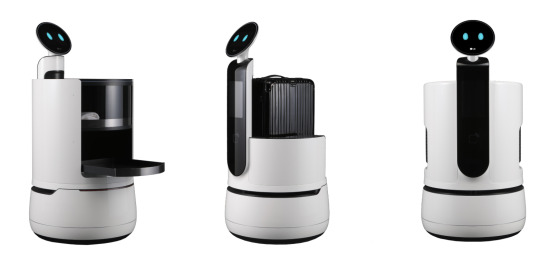
LG’s new service robots are designed for restaurants, hotels, and grocery stores.
Sony is re-introducing its Aibo robotic dog, this time in a more advanced, more puppy-like incarnation (probably $1,700 when it hits the U.S.). Sensors make the dog respond appropriately when you pet it or swat it; it learns your voice over time and seeks you out; and, like the original Aibo, it plays fetch with a pink ball.
youtube
Omron built a ping-pong-playing robot — not ever intended to be for sale, but to show off its robot-making skills.
Just to make sure all of Vegas’s bases were covered, the Sapphire Gentlemen’s Club featured two pole-dancing stripper robots as a CES gimmick.
Hail to the VICTORs
So, you get it: Same as last year, just more of it.
If all of that seems like a lot to read, well hey — here’s a rhyme to make it go down easier:
V is for the voice control in every gadget here —
“Alexa, do my bidding!”… “OK Google, bring my beer!”
In TVs, cars, and speakers, it’s a miracle of choice.
The world’s at your command — at least if you don’t lose your voice!
I is for the second realm, called Internet of Things,
It’s networked household stuff, complete with all the fun that it brings
It’s thermostats, refrigerators, all your kitchen gear…
So far, nobody’s buying it — but hey, perhaps next year.
C is for self-driving cars! So many at this show!
We’re told they’re really coming soon — about two years to go.
T is for the TV screens on all the expo floors.
They look amazing when they’re here — but less so once they’re yours.
O is for the oddball stuff! The offbeat and bizarre:
This laundry-folding robot, or this crazy concept car.
R is for the robots — Sony’s puppy stole my show.
This grocery bot asks what you want, then shows you where to go.
So there’s your whole mnemonic — VICTOR! Hope you liked the show
And don’t forget the greatest part — you didn’t have to go!
David Pogue, tech columnist for Yahoo Finance, welcomes non-toxic comments in the Comments below. On the Web, he’s davidpogue.com. On Twitter, he’s @pogue. On email, he’s [email protected]. You can sign up to get his stuff by email, here.
Read more:
Exclusive: What Fitbit’s 6 billion nights of sleep data reveals about us
Tech that can help you keep your New Year’s resolutions
Pogue’s holiday picks: 8 cool, surprising tech gifts
Google’s Pixel Buds: Wireless earbuds for the extremely tolerant
Study finds you tend to break your old iPhone when a new one comes out
Rejoice: Sonos Speakers are finally voice-controllable
Follow Yahoo Finance on Facebook, Twitter, Instagram, and LinkedIn
#tech#$SSNLF#_uuid:819089a2-8b67-3b1c-8498-a3c62627a980#Pogue#_lmsid:a077000000BAh3wAAD#$GOOGL#_revsp:yahoofinance.com#$GOOG#CES 2018#_author:David Pogue#$AMZN
9 notes
·
View notes
Text
Microsoft CEO talks about immigration, empathy, and cricket
yahoo
This past Sunday, “CBS Sunday Morning” aired my profile of Satya Nadella, who’d worked at Microsoft for 25 years before being chosen to become the third CEO in Microsoft’s history. (You can watch the CBS story here.)
Nadella’s thoughtful, gentle personal style could not be more different from the brash, aggressive approaches of Bill Gates and Steve Ballmer. So far, his style seems to be working: Microsoft’s (MSFT) stock has more than doubled in the three years he’s been at the helm.
I spent an entire day with Nadella, including some time in his home with his wife Anu and son Zain. As always, we had time for only pieces of the interview on TV — so here’s a more complete edited transcript.

Satya Nadella sat down for an interview for “CBS Sunday Morning.”
Pogue: In your book, “Hit Refresh,” you talk a lot about empathy and compassion. Bill Gates and Steve Ballmer, during their tenures here, had terrific strengths, but I’m not sure compassion would be the word that jumps out.
Nadella: In their own way, I feel that they have a lot of that, very deep. But when I think about empathy or compassion, pick your word, I just don’t think that this is a soft skill that’s nice. I think it’s a business essential.
And I’ll tell you why. We are in the business of meeting unmet, unarticulated needs of customers all over the world, long before even they can articulate it. If we can do that, then we will be successful. If we can’t, we won’t. It’s an essential skill, an essential attribute, for product creation.
Pogue: And yet at this time in America, compassion seems harder to come by than in other times.
Nadella: I’m a product of two amazingly unique American things. One is American technology reaching me where I was growing up, and making it possible for me to dream; the other is the enlightened American immigration policy, allowing me to come and live that dream.
When I sit here, as unlikely CEO of Microsoft, both of those come to mind. So I’m long-term optimistic. I always will say that in the U.S., the real currency is that ability to take differences and bring people together to make our society a stronger society.
Pogue: What is your relationship with the president?
Nadella: I’ve had a chance to meet him a couple times. Once before he was inaugurated, in Trump Tower, and once after, when he called all the tech leaders to meetings in the White House. Good conversations.
I mean, one of the core goals that the administration has is to modernize the government, the technology. And we obviously have longstanding relationships with all the government agencies, and it’s much needed.
Pogue: But what about this initiative, the DACA repeal? Sending home children of undocumented immigrants in this country? A number of them work here at Microsoft. You’ve publicly disagreed with that.
Nadella: Absolutely. Wherever there is any public policy that is not sympathetic to diversity and inclusion, foundational human values that we care deeply about, our employees care deeply about, we’re gonna be very principled in our opposition to it.
Pogue: And you have offered to do something for the employees of Microsoft who will be affected by this DACA repeal…
Nadella: We’ll fight on their behalf, in the courts. We will intervene wherever and however possible. Like we are in other areas, like privacy.
Pogue: Having read the book, you strike me as a kinder, gentler CEO. It seems you want people to get along. For example, you express frustration at the fiefdoms and bickering you inherited among Microsoft employees. You inherited lawsuits that had been dragging on in court, with Samsung and others, and you said, “Guys, guys, guys. Can’t we work it out?” And you raised a lot of eyebrows when you started writing Microsoft Office products for your direct competitors, like iPhones.
Is that a good characterization of your style?
Nadella: Yeah. It is. It’s not about viewing this as zero sum. It’s being able to face up to the realities. I like to describe this as courage in the face of reality.
But at the same time, looking back at our history has been helpful. The number of billion-dollar franchises that were built on Windows is far greater than any other platform. So I said, “Okay. Let’s start viewing today’s world with what made us good in the first place.” So when it comes down to, “hey, there are a billion smartphones!”, it only makes business sense for us to make sure our customers can use our applications and our cloud services on them.
Pogue: Your new strategy is “Cloud first, mobile first.”
Nadella: Actually, we’ve updated that.
There is more technology in our life, not less, with each passing day. We started with mainframes, and then to PCs, which we had on our desks. Now we have smartphones in our pockets. Now we have sensors that go beyond the pocket — on your wrist, or holographic or mixed reality computing, where what you see is a mix of the analog and the digital world.

Microsoft’s Alex Kipman shows me his team’s Hololens, an augmented-reality visor.
So we are in the secular march to more and more computing in our lives. So what technological paradigm makes all this possible? That’s what we describe as the intelligent cloud and the intelligent edge. We’re evolving to more of an intelligent cloud and an intelligent edge, which means that you’re going to have many, many devices.
Pogue: So the cloud is, in super simple terms, the control center that’s on the internet; what’s the “edge”?
Nadella: All the devices, and the application experiences that span all the devices.
Pogue: That’s where the edge of the cloud meets the real world?
Nadella: That’s correct. That’s a great way to describe it.
You will go from device to device, whether it’s in a conference room, your work, or in your home. You’re gonna have thermostats, TVs, speakers, PCs, phones, and your app is going to be spread across all of it. The experience is going to be spread across all of it. It’s enabling you to be mobile, as opposed to the device being mobile — that’s the architecture that we’re moving towards.
Pogue: Microsoft famously missed the boat on smartphones. I actually liked Windows 10 on the phone a lot — why did it fail?
Nadella: Sometimes these digital ecosystems have real “network effects.” The first one to the market shapes it, and then there’s always room for the second one. But whenever it comes down to third or fourth ecosystems, they’re hard.
The lesson I learned from our own obsession of PC being “the hub for all things, for all time to come,” is that there’s no such thing as one device that’s going to be the hub for all things for all time to come! Everybody thinks that the current devices is the last device you’ll ever need — until it’s not.
And so the question is then, what is the constant here? The constant is the person. And so if you start building useful services to them, that span all their devices… Whether it’s a phone, a PC, a large screen in my office, a speaker — all of them are Office 365 devices.
Pogue: Cloud services has been a big push of yours, right? Where you provide other companies with these gigantic data farms that are too expensive and technical to run themselves?
Nadella: Absolutely. This is a push that actually Steve got started, and while working for Steve, I started some of our infrastructure side.
These are fast-growth businesses. We now have in excess of $20 billion run rate — and growing at a very, very fast clip. And so it requires both a significant amount of capital investment, and great innovation in software. And we’re excited about the future. For example, one of the big, new things that we are doing is, how do we infuse into all of our cloud services artificial intelligence?
You can now use PowerPoint, and while you’re presenting, automatically translate what you are saying into 60-plus languages simultaneously. That’s AI in action. But every app developer on Azure [Microsoft’s suite of cloud services] has access to that same capability, and that’s really what’s on our agenda.
Pogue: You’re really doubling down on Microsoft’s investments in AI. But some experts, Elon Musk and Stephen Hawking, are deeply concerned about our rush into artificial intelligence. They’re saying, “Slam on the brakes,” not slam on the accelerator.
Nadella: The way I come at it is perhaps a little more pragmatic.
The rate of progress in AI is stunning, there’s no question. But anything like AGI, or Artificial General Intelligence, we are some ways away. That’s where the machine is as good as a human being in everything.
Think about humans. We can be put in a new environment. We’ll learn. We’ll adapt. But the roadmap to achieving something like that in AI is a long ways away. We are very, very early on.
But to your point, we as creators of AI have a real responsibility to make some design decisions. We should build AI that we can be accountable. I don’t want us to abdicate. “Oh, we created some program that learns. We don’t know how it learns.” That’s just not a way for us to proceed.
Pogue: In your book, you write movingly about the birth of your son, Zain, who’s quadriplegic; there’s an implication that that event changed you.
Nadella: Yeah. There have been a few moments where, in my personal life, there were really these “hit refresh” moments, and Zain’s birth clearly was one such. A few hours before Zain was born, if somebody had asked me, “What are the things that you are thinking about?”, I would have been mostly thinking about, “How will our weekends change?” And childcare, and what have you.
Obviously, after he was born, our life drastically changed. My wife Anu had to drop out of the workforce to take care of him fulltime. To be able to see the world through his eyes, and then recognize my responsibility towards him, has shaped a lot of who I am today, and shaped even how I show up in other places, whether it’s at work or with my other children.

Satya and Anu Nadella met in India when they were in elementary school.
Pogue: So that empathy has even changed how you lead?
Nadella: When you lead, there’s no way you can motivate anyone if you can’t see the world through their eyes.
There’s no way you can get people to bring their A game if you can’t create an environment in which they can contribute. But creating that environment requires you to be in touch with, what are they seeking? What motivates them? What drives them? What are their needs?
And, of course, the fact that you practice empathy at work will only make you a better parent, a better partner, and a better person all around.
Pogue: Well, I know one thing you probably miss, having moved to America. You have no one to talk to about cricket.
Nadella: Well, I mean, it’s no longer true! Because in this connected world of ours — one of my subscriptions is for a TV channel. And so I’m watching cricket all the time.
Pogue: All right, we have about 10 seconds left. Explain to me the rules of cricket.
Nadella: No. (laughs)
David Pogue, tech columnist for Yahoo Finance, welcomes non-toxic comments in the Comments below. On the Web, he’s davidpogue.com. On Twitter, he’s @pogue. On email, he’s [email protected]. You can sign up to get his stuff by email, here.
#_uuid:74d0da62-8d25-3fb5-90f2-241e105bd82a#_lmsid:a077000000BAh3wAAD#_revsp:yahoofinance.com#$MSFT#_author:David Pogue
2 notes
·
View notes
Text
This week's David Pogue Rated:App is on Facetune
yahoo
Welcome to David Pogue’s Rated:App! series. Each week, I’ll buy whatever the No. 1 bestselling app is (on the iOS or Android store) and review it. Maybe I’ll wind up saving you from a few wasted bucks. If you’re viewing this video on your phone, the video plays vertically to fit your screen exactly, so you can see what it’d look like if you were running the app yourself.
Last week’s No. 1 bestselling app on the Apple app store was Facetune. If you’re an Instagram nut, that’s no big news; you’re already well aware of apps like this. In fact, Facetune has been around since 2013.
So why did it spike to No. 1 the week of Jan. 28? Even Lightricks, the company in Israel that makes it, doesn’t know. “We haven’t made any change recently,” a rep wrote me. “Perhaps we received some press and that boosted our sales.”
Anyway, Facetune is a selfie-retouching app — incredibly easy to use, with incredibly professional-looking results. With a few swipes of your finger, you can make your teeth whiter, your skin smoother, your eyes bigger, and your nose smaller. You can tap a zit into nonexistence, or make your waist a little thinner. It’s like Photoshop without the complexity (Facetune’s built-in, animated help screens show you exactly how to use each tool). It’s a must-have for anyone who lives and breathes Instagram.

Facetune has smoothed the skin and whitened the teeth of millions on Instagram.
At any time, you can tap the button in the lower-right for a before/after comparison with your original shot. And you can tap the button in upper right to post the photo to Instagram, send it to another app, send it by email, or save it to your camera roll.
The cost for all this magic is $4 for iOS, and $6 for Android.
The app is not only well done and practically idiotproof; it also appeals to our universal vanity. No wonder it’s become a mega-hit.
The danger zone
You do have to be careful when you use Facetune, though. Instagram is full of people who’ve dragged their finger too much, resulting in teeth that are creepily nuclear white, or skin that looks like some kind of plastic mask. It’s freaky and unnatural. It makes you look like you’re inflatable.
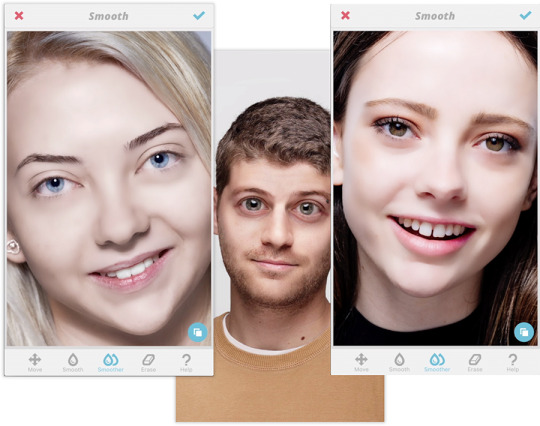
Welcome to the age of FaceTune, where everybody’s skin looks like vinyl.
But that doesn’t stop many of the citizens of Instagram (and Tinder, and Match…) from Facetuning themselves. After all, that’s how the stars of Instagram look! Why shouldn’t we all look airbrushed into plastic?

The stars all have freaky-smeared skin—why shouldn’t you?
Heck, once you learn to recognize that freakishly smeared skin tone, you realize that even Instagram’s stars probably use Facetune, too. Khloe Kardashian even admits it. (“It’s life changing,” she told Chelsea Handler. “It’s the only way to live.”)
There’s another danger, of course: That people will start to feel ugly and ashamed if they don’t look like they’ve been airbrushed. That Facetuned photos create an unrealistic expectation of beauty. That somebody will meet you in real life and be appalled. (There is, in fact, a #NoFacetune hashtag making the rounds, a sort of “What I Actually Look Like” seal of authenticity.)
Actually, there’s a third danger: That you’re not going to read Lightrick’s legalese. It includes this alarming line: “You grant…to Lightricks a worldwide, non-exlusive, royalty-free… license.. to use, reproduce,…make available to the public… [and] broadcast… that Content [your photos].” Ummmm, what?
I’m sure that this is just standard lawyer boilerplate stuff (Facebook and other companies have gotten burned by this kind of language coming to light), and that Lightricks would, in fact, not try to steal your photos for marketing purposes. But you know… now you know.
Facetune 2
Actually, there’s a final danger — that you’ll get confused over the version of FaceTune you’re getting.
The old one, called just Facetune, is the one that spiked last week; it costs $4 or $6.
The new one, called Facetune 2, includes many of those same features for free:
Whiten your teeth, smooth your skin, remove skin shine, bring out eye detail
Make any body part bigger or smaller
Make your smile bigger, your jaw bigger or smaller, your face wider or narrower
Apply filters, superimpose colorful lens flares, paint new skin tones onto your face
Crop, vignette, adjust contrast and brightness, sharpen
Defocus the background
In fact, Facetune 2 lets you apply many of those features before you take the photo — in the live preview — or even in a video that you record in the app. That’s some hard-core face recognition. (You can see it at work in my video, above.)
Facetune 2 also offers a bunch of premium features, which you can unlock by paying through the (slimmed-down) nose. You can pay either a one-time $70, or you can pay $6 a month (or $36 a year). Man, you gotta be a hard-core Instagrammer to pay that much for selfie touchups.
What do those “VIP” features get you? Some pretty amazing stuff.
Paint in a totally new backdrop behind you
“Relight” the shot, changing how the light falls on your face (incredible)
Change the height, width, angle, or spacing of your eyes, and make similar adjustments to your nose
Go full-on Photoshop with vibrance, saturation, color-temperature controls; bring detail out of shadows or highlights
Auto-darken eyebrows, auto-reduce eye bags
“Patch” blemishes and moles (that’s free in the old FaceTune version)
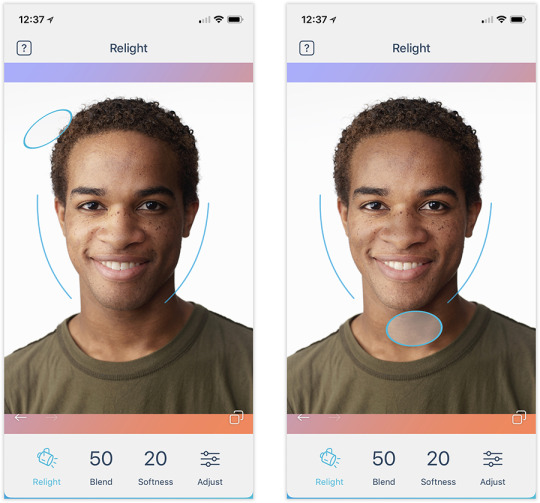
In Facetune 2 (the paid version), you can move the “light” around your face.
So here’s my advice: Save yourself even the four bucks you’d spend on the old version. Get the free Facetune 2, even though that’s not the No. 1 app, and just plan to ignore all those “VIP” banners across the advanced, paid-only tools.
Unless, of course, your vanity gets the better of you.
David Pogue, tech columnist for Yahoo Finance, welcomes non-toxic comments in the Comments below. On the Web, he’s davidpogue.com. On Twitter, he’s @pogue. On email, he’s [email protected]. You can sign up to get his stuff by email, here.
#tech#FaceTune#app#_lmsid:a077000000BAh3wAAD#_revsp:yahoofinance.com#_uuid:81fe9fe7-2b7d-3a44-8590-8b1460b59368#_author:David Pogue
3 notes
·
View notes
Text
Readers weigh in on Pogue's Apple HomePod listening test

An Apple Store staff member demonstrates how the Apple HomePod, home sound system, works at the Apple store in Manhattan, New York, U.S., February 9, 2018. REUTERS/Shannon Stapleton
Here are three great ways to rile up Twitter users: Comment on the president. Say something about immigration. Review speakers.
That’s what I discovered when I posted the results of a blind listening test I conducted last week, in which five panelists were asked to rank the sound quality of an Apple HomePod, Sonos One, Google Home Max, and Amazon Echo Plus. (Go ahead and read it; I’ll wait right here.)
Nobody ranked the HomePod as No. 1 on most songs. For three panelists, the Sonos One was the overall winner; for the other two, the Google Home Max.
I was surprised, because most tech critics ranked the HomePod as the best. So did I, when Apple set up the blind listening test. (Here’s my full review of the HomePod.)
Soon enough, my little test started bouncing around the Twitterverse; here are some of the most popular theories and critiques of the test.
The curtain blocked the sound
The most common complaint about my test setup is about the curtain, which I used to hide the speakers from the panelists’ view. “I would think the curtain will block the highs, which is what HomePod excels at,” tweeted @toxicpath and others.
I don’t think that’s it. First, the cloth I used is extremely sheer — you can see right through it. It’s a single ply of very thin fabric.

The “curtain” was a piece of very sheer fabric.
Second, if the cloth affected the sound of the HomePod, wouldn’t it have affected the sound of its rivals in the same way?
Third, I used the same cloth the night before, during the dress rehearsal, when both panelists ranked the HomePod as the winner.
Some readers suggested repeating the test with the panelists’ backs turned to the speakers. That setup wouldn’t pass muster, either — our ears are naturally scooped to collect sound from the front.
Other readers proposed blindfolding the panelists. Well, OK, but how would they take their notes and record their rankings during the five musical tests of four speakers?
The curtain prevented the HomePod from adapting
The HomePod contains six microphones. They’re supposed to sample the proximity of the walls and ceilings around it, and reconfigure what’s coming out of it so that the important stuff is blasted “forward,” seven tweeters noted
“Since the HomePod adjusts its sound to the acoustics of the room, you should not have used a piece of fabric to hide the speakers,” wrote @markbooth and others. “The fabric may have affected the HomePod’s sound.”
Well, no. The HomePod re-samples its listening position after each time it’s moved, during the first few seconds of music playback. We let the HomePod do its room listening before hanging the curtain, so it had already had the chance to adjust its sound.
The listener positions affected their perceptions
One of the most interesting observations came from people like @JazzStevo. He noticed that the five listeners sat in a row, with the speakers in a parallel row. And when the results were tallied, the listeners closest to the Sonos One end all preferred the Sonos One!
Similarly, the listeners closest to the Google Home Max end both preferred the Google Home Max! (He made this cool diagram to make the point.)

@JazzStevo made this diagram, to show the positions of the four smart speakers (top) and the top-rated speaker choices of the five listeners (bottom).
It’s well established that loudness affects our perception of speakers. Before the test, we did volume-match the four speakers using a meter — but if you’re at the same end of the row as a certain speaker, of course it’s closer to you, and therefore louder!
There’s one huge problem with this theory, though: Why wouldn’t the center speaker, the Apple HomePod (B in the diagram), therefore sound best to the center listeners directly in front of it?
It doesn’t make sense that the center panelist would perceive speaker D as being the loudest.
Spotify over AirPlay has lower quality
One of the most compelling theories came from people like @osaddict: “I wonder if you would have gotten different results had the HomePod streamed directly from Apple Music. I have noticed some difference vs AirPlay.”
“Spotify over AirPlay is very underdriven,” adds @jaydisc. “AirPlay Spotify sounds shockingly worse than Apple Music streaming,” says @ErikVeland. “There’s definitely magic EQ sauce being applied to Apple Music that’s not in AirPlay.”
In other words, they’re saying, streaming Spotify over AirPlay (Apple’s Wi-Fi-based wireless streaming protocol) may not sound as good as streaming Apple Music to the HomePod. (To keep everything equal, my testing involved streaming the same songs from the same Spotify playlist to all four speakers.)
If true, that would easily explain why the HomePod won Apple’s listening test, and lost mine.
I checked with Apple; the reply was that there should be no such degradation as long as the Wi-Fi network is strong.
I did some testing of my own, playing the same song directly from Apple Music and then streaming from AirPlay and Spotify. @jaydisc is quite correct: In general, the songs from Apple Music come in at a higher volume than they do from Spotify. To make the songs sound identical, you have to boost the Spotify volume by a couple of notches.
Once you do that, though, there’s really no perceptible difference in the sound quality. I spent a whole morning doing comparisons — 30 different songs in different genres, “A/B”-ing them between Apple Music and volume-adjusted Spotify, over and over again, at different volume levels and listening positions. I made myself crazy trying to hear a difference.
If there is one, I swear that it’s too small to identify in regular use. It couldn’t have made a difference to my listening panel.
In any case, it would be impossible to control for this variable in a speaker comparison test, since none of the other speakers can stream from Apple Music.
Consumer Reports
In the meantime, I’m not the only one who’s been doing HomePod listening tests.
Consumer Reports finished up their testing of the HomePod, and concluded that “it’s not the best-sounding wireless speaker in our ratings — or even the best-sounding smart speaker.”
Maria Rerecich, the magazine’s director of electronics testing, was kind enough to share the details of her team’s testing process.
“It’s not a bad test, what you did,” she told me. “Having people come in and listen to it is a good thing to do.”
But her team’s goal was different. “We’re looking for fidelity and accuracy to the original tracks, more than somebody saying ‘Hey, that sounds good,’” she explained. Because, for example, “some people like bassy music, some don’t.”
So her team plays various kinds of tracks. Some are instrumental (“Are the instruments clear? Are they located in space properly? Are you getting a sense of the room they were in?”), vocals (“Are the treble, midrange, and bass clear? Is anything out of balance? Is the midrange muddy? Is anything oddly sizzly or peaky? Are there good dynamics?”), and so on. “We use the same tracks all the time,” Rerecich says, “so we know what they sound like.”
They compared the HomePod and other smart speakers against high-end reference speakers, which the magazine has all rated Excellent. “We can flip back and forth from the reference speakers to the test speakers; everything’s synced to the same track,” she says.
The bottom line? “Overall, the sound of the HomePod was a bit muddy compared with what the Sonos One and Google Home Max delivered,” says the resulting article.
Metered tests of static
FastCompany.com did some tests, too — not by listening, but by having the HomePod play white noise (static) and measuring its acoustical properties.
They enlisted NTi Audio AG, a manufacturer of acoustics testing equipment. “The company was kind enough to loan us a testing device, software, and a special microphone so that we could test the HomePod in a real-life natural habitat–my living room,” writes Mark Sullivan. “The company’s Brian MacMillan coached me on how to do the tests, then he and some other NTi people analyzed (and helped me understand) the results.”
The results? “’The developers have done an excellent job of having the HomePod adjust to the room; (it has) Impressive consistency in overall level and frequency response,’ said NTi’s MacMillan.”
On Reddit, an audio fan, WinterCharm, spent 8.5 hours testing the HomePod, using audiophile equipment: a calibrated microphone, Room EQ Wizard software, and a lot of technical knowledge. He measured the frequency response — again, not of music, but of a sine wave.
“What apple has achieved here is incredibly impressive — such tight control on bass from within a speaker is unheard of in the audio industry,” he writes. “What Apple has managed to do here is so crazy, that If you told me they had chalk, candles, and a pentagram on the floor of their Anechoic chambers, I would believe you. This is witchcraft. I have no other word for it.”
But he, too, then got enough methodology pushback from readers — over 1,400 comments, including this reply from Redditor edechamps, which calls his analysis “hilarious” and “garbage” — that he wound up backing off from his original conclusions.
Recipe for the perfect test
Many readers found fault with my testing protocol, and had suggestions to improve it. “I would suggest someone other than Grandpaw Pogue devise the test,” wrote @Dayv. “Pogue is bad at this and he should feel bad.”
@Dayv, and others, offered a simple prescription for a better test:
“Repeat the test with the speaker samples in a more randomized order,” he says. “Doing A, B, C, D or D, C, B, A gives undue weight to D and A. Need truly randomized ordering, and a lot more tests.” (My test was fairly random. I sometimes started with speaker A, and sometimes with speaker D. I also offered panelists the opportunity to hear any speakers again in any combination or order, which they often requested.)
“Blindfold them and have them take voice notes on an app, so that they can speak freely without influencing the other panelists,” adds @jocrz. “This would require the test to be given to one person at a time.”
“The people are sitting really close to all of the speakers — these are room devices, not desk speakers,” @Dayv goes on.
“I would sit each speaker alone on a table, blindfold listeners, and seat them around it,” suggests @jdmuccigrosso.
“You need an anechoic chamber if you want good measurement accuracy,” writes Redditor Edechamps. “It is impossible to accurately measure a speaker in a normal room.”
@cribasoft proposes “an all black media room. “I promise if you put the speakers on a table at the front, and only provided directional lighting where testers are sitting, they could see their paper but not any of the speakers.”
“Need a lot more opinions. Test people separately in the same seat,” says @Dayv.
And, of course, I’d have to persuade Google, Amazon, and Sonos to add Apple Music to their speakers, so that they’re all streaming from the identical servers.
Wow. That would be quite a test.
But you know what? If you need that much effort to hear that one speaker is obviously superior… well, then it probably isn’t.
I suspect, in the end, that my original conclusions are correct: That different pieces of music are different, and the people listening to it are different. There is no right answer.
David Pogue, tech columnist for Yahoo Finance, welcomes non-toxic comments in the Comments below. On the Web, he’s davidpogue.com. On Twitter, he’s @pogue. On email, he’s [email protected]. You can sign up to get his stuff by email, here.
Related:
Head to head, does the Apple HomePod really sound the best?
Apple’s HomePod speaker: Either way late or way early
David Pogue’s sneak preview of the Apple HomePod
#Apple#_lmsid:a077000000BAh3wAAD#_revsp:yahoofinance.com#$AAPL#_author:David Pogue#_uuid:6b44a1ce-f178-3617-839d-2280656dbb09#HomePod
2 notes
·
View notes
Text
The tiny, 4K Mavic Air crushes other DJI drones
yahoo
Every consumer product goes through three stages of life. It’s invented; it’s improved and adjusted; and, finally, it becomes a commodity. There’s not a lot of innovation anymore in microwave ovens, ceiling fans, or toilets — they’ve pretty much stopped morphing. They’ve reached the third stage, their ultimate incarnations.
Drones, love ‘em or hate ‘em, are still in the second stage: They’re rapidly changing direction, gaining features, finding out what they want to be. It’s an exciting period in this category’s life, because new models come out fast, each better and more interesting than the last.
For proof, just look at the Chinese company DJI, the 800-pound gorilla of drones. It releases a new drone or two every single year.
They’ve just introduced a drone called the Mavic Air ($800). It’s so small and smart, it makes you wonder why anyone would buy the 2016 Mavic Pro, which costs $200 more — but it’s not what you’d call perfect.
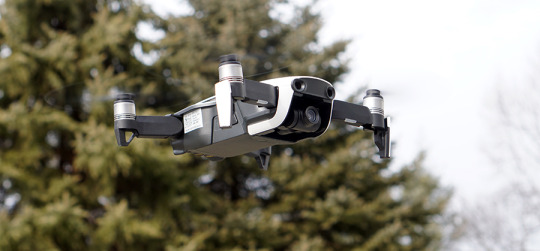
The new Mavic Pro is incredibly tiny, stable, and lightweight.
Meet the Air
The 15-ounce Mavic Air is small — and that’s huge. It folds up for travel: its four arms collapse against the body to make the whole thing small enough to fit into a coat pocket, about 6.5 inches by 3.5 inches by 2 inches. (The top two arms swing horizontally, as you’d expect. The bottom two, though, are hinged in two dimensions: They fold downward and inward, and you have to remember to do those before you do the upper arms. You’ll figure it out.)
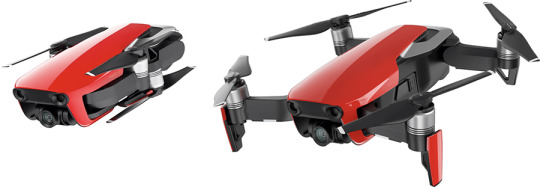
The Mavic Air’s arms fold up.
Of course, there are plenty of small drones — but not in this league. The Mavic Air, for example, can capture gorgeous 4K video. And its camera is on a three-axis gimbal for stabilization; the video looks like it was shot from a tripod even when the drone was being buffeted by 20 mph winds, as you can see in the video above.
The box includes the drone, a remote control (it uses your smartphone as its screen), a battery, a charger, a set of propeller guards for indoor flying, and a spare set of propellers (in crashes, they’re the first to go).
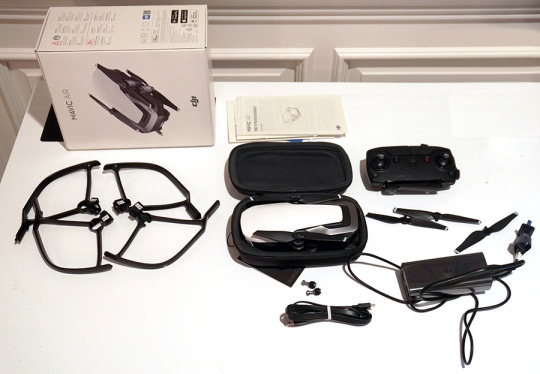
The Mavic Air comes with four propeller guards for indoor flight, 1 battery, a case, spare propellers and a charger.
The Mavic Air is also smarter than any sub-$1,000 drone DJI has ever made. It has depth-sensing cameras on three sides — forward, down, and backward (that’s new) — so that it can avoid collisions automatically in those directions.
Like most drones, this one has an automatic Return to Home feature that kicks in whenever the battery is getting low or if it loses the signal with the remote control. (You can also call it home with one button press whenever you’re just feeling anxious.) Thanks to the cameras underneath, this thing lands exactly where it took off — within a few inches.
The competitive landscape
The Mavic Air’s primary competition comes from two other DJI drones. Here’s the rundown:
Mavic Pro (2016 model, $1,000). Twice the size of the Air. Folding arms. 4K video. “27 minutes” of flight per charge (in the real world, 22 minutes). Front and bottom collision avoidance. Remote control included with built-in screen (no phone necessary). Very few palm control gestures (see below).
Mavic Air (2018 model, $800 — the new one). Folds up. 4K video. “21 minutes” per charge (more like 18). Front, bottom, and back collision avoidance. Remote control folds up tiny — even the joysticks unscrew and store inside the body, for even smaller packing. Has the most palm gestures of the three drones — and the most reliable palm gestures. 8 GB of internal storage for video and stills, so you can still record if you don’t have a micro SD card on you. Another $200 buys you a “Fly More” kit that includes two extra batteries, an ingenious folding four-battery charger, and even more spare props.
Spark (2017 model, $400). The smallest body of all, but its arms don’t fold, so it winds up being bigger for travel. 1080p video. “18 minutes” per charge (more like 11). Front and bottom collision avoidance. Remote control is an extra purchase ($120); uses your phone as a screen. Responds to hand gestures, but not reliably.
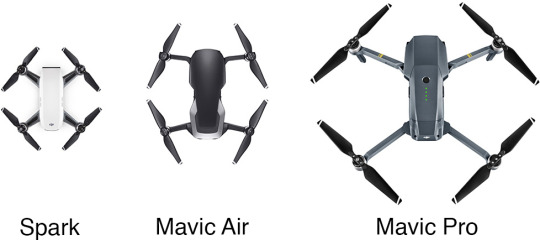
The Spark may look smaller than the Mavic Air, but remember that it doesn’t fold up.
True, the Mavic Pro gets a little more flight per battery. And there’s an even more expensive model, the $1,100 Mavic Pro Platinum, that gets “30” minutes per charge.
(Do those seem like incredibly short flights? Yup. But that’s drones for you. As it is, a modern drone is basically a flying frame designed to haul its own battery around.)
But in my book, the Air’s tiny size is far more important than the marginally greater battery life. As the old saying doesn’t go, “The best drone is the drone you have with you.”
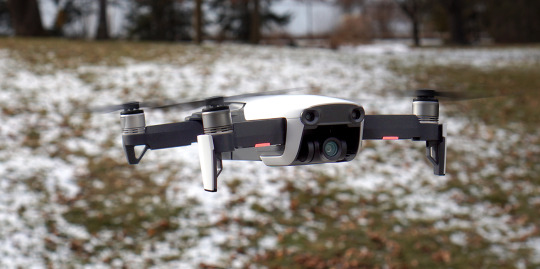
Only the front “arms” have landing gear (the white thing), which fold up for travel.
In-flight entertainment
You can fly the Mavic Air in three ways.
First, you can use the included remote control. If you insert your smartphone into its grippers and connect the little cord, you get a number of perks — like actual joysticks, which make the drone much easier to fly than using the phone alone. The remote also has a dial at the outer corner for adjusting the camera’s tilt in flight, as well as a switch for Sport mode, which unlocks the drone’s top speed of 42 mph (by turning off the obstacle-avoidance features).
The remote also gives the drone a much greater range. It uses a Wi-Fi connection to the drone, instead of the proprietary radio connection of the Mavic Pro. DJI says that still gives you 2.4 miles of range, but I say baloney; even in the middle of the Texas desert, you’ll be lucky to get half that distance. It doesn’t really matter, though, since Federal Aviation Administration rules say you can’t fly a drone out of sight. (Speaking of the FAA: You don’t need a license to fly the Mavic Air as a hobby, but you do need to register the drone itself. And if you intend to fly it professionally — this means you, wedding videographers, filmmakers, construction firms, realtors, police, and farmers — you have to get permission from the FAA.)
The second way to fly the drone is using your smartphone. It works, but you get a much shorter range (about 250 feet), and it’s harder; DJI’s app has become one super-crowded, complex piece of software.
The third way: using hand gestures. The drone must be facing you at all times, and it has to remain pretty close to you, so this trick is primarily useful for positioning it for “dronies” (selfies from the air). Keep in mind that you also need the phone app with you, though, to turn on the palm-control mode.
You stand with your arm out, palm forward, in a “Stop! In the name of love!” pose. Now, you can “drag” your hand up, down, or around you; the drone follows as though connected to your palm by a magnet. It’s the next best thing to The Force.
New, two-handed gestures let you push the drone farther away or pull it closer to you. And you can now make the drone land by pointing your palm toward the ground and waiting.
In the previous model, the Spark, those palm gestures were super iffy; sometimes they worked, sometimes not. The Mavic Air makes them far more reliable, although I never got the new “take off from the ground” gesture working.
As in other DJI drones, the Mavic Air can follow you as you ski, bike, drive, or run (it tracks you optically — you don’t have to have the remote control on you). Unlike earlier ones, this one doesn’t just hover when it encounters an obstacle; it actually attempts to fly around the obstacle and keep going.
How’s it look?
“4K” may be a buzzword, but it doesn’t automatically mean “great picture”; it could refer to 4,000 pixels’ worth of ugly blotch.
The Mavic Air contains the same tiny camera sensor as the Spark and the Mavic Pro. The footage and stills generally look terrific — anything shot from the air is automatically kind of stunning, and the Air uses more data (100 Mbps) to record data than the Pro does.
Unfortunately, this sensor is still fairly disastrous when it comes to dynamic range. That is, it tends to “blow out” bright areas and “muddy up” dark areas. Alas, those are things you get a lot of when you’re shooting from the sky.

The Mavic Air’s footage is often marred by blown-out highlights (sun, left) and goopy, murky shadows (people, right).
The Air can also do half-speed slow motion (in 1080p, not 4K), and take high-dynamic range photos (not videos).
All of these drones offer preprogrammed flight patterns, called QuickShots, that make great 10-second videos, incorporating flight maneuvers and camera operations that would be incredibly difficult to do yourself.
For example, the one called Circle makes the drone fly around you, keeping the camera pointed toward you the whole time; Helix makes the drone spiral out and away from you; and so on. There are two new ones: Boomerang flies a grand oval around you, up/out and back. Asteroid combines a flight up and away, with a spherical panorama. On playback, the video is reversed, so that it seems to start with a whole planet earth viewed from space, as the camera rushes down toward you. Here, have a look.
But it’s small
Like all drones in this price range, the Mavic Air is complicated and sometimes frustrating. It does a lot of beeping at you, it’s still full of options that are “not available now” for one reason or another, and it still doesn’t come with a printed instruction manual.
And yeah, someday, we’ll look back and laugh at an $800 drone that flies for only 18 minutes.
But you can’t buy a dream drone that doesn’t exist. And among the ones that do, the Mavic Air is ingeniously designed, impressively rugged, and incredibly small. Its features beat the cheaper DJI Spark in every category — and even the more expensive Mavic Pro in almost every category.
In other words, if you’re the kind of person considering a drone, the Mavic Air strikes a new sweet spot on the great spectrum of drones, somewhere between beginner and pro, between tiny and luggage-sized, between cheap and pricey. Invest as much time learning it as you’ve invested in buying it, and you’ll be flying high.
David Pogue, tech columnist for Yahoo Finance, welcomes non-toxic comments in the Comments below. On the Web, he’s davidpogue.com. On Twitter, he’s @pogue. On email, he’s [email protected]. You can sign up to get his stuff by email, here.
Read more:
Exclusive: What Fitbit’s 6 billion nights of sleep data reveals about us
Tech that can help you keep your New Year’s resolutions
Pogue’s holiday picks: 8 cool, surprising tech gifts
Google’s Pixel Buds: Wireless earbuds for the extremely tolerant
Study finds you tend to break your old iPhone when a new one comes out
Rejoice: Sonos Speakers are finally voice-controllable
Follow Yahoo Finance on Facebook, Twitter, Instagram, and LinkedIn
#Mavic Air#DJI#_lmsid:a077000000BAh3wAAD#_revsp:yahoofinance.com#_uuid:f3024972-b485-347a-ac1a-13f792608cec#_author:David Pogue#drone
2 notes
·
View notes
Text
Google Clips uses AI to snap pictures of your kids and pets — sort of
yahoo
In its day, Google has produced some truly bizarre hardware products. (Remember the Nexus Q, Google’s “set-top sphere”? Me neither.)
Well, don’t look now, but here comes the company’s weirdest hardware yet: Google Clips ($250).
It’s a tiny, thin camera, about the size of two stacked Triscuits, that combines elements of a spy camera, GoPro camera, and cellphone camera.

Google’s latest hardware product is a strange little AI camera.
The Clips is designed for parents (of children or pets). Of course, we all have perfectly good cameras in our phones — actually, better cameras. But using only our phones presents a few problems:
You’re never in the pictures with your your kid or pet.
Babies and toddlers often stop whatever cute thing they’re doing when they see your phone come out, because it’s kind of big and intrusive.
You can’t predict when your subject is going to do something adorable; odds are pretty good that you’ll miss it.
If you film or shoot enough that you always capture the good stuff, then you’ve got endless quantities of stuff to edit.
All your photos and videos of your kid are taken from the same angle: Your height.
The Clips is just thick enough that it can balance on its edge. It also comes with a rubbery holder/case, which can act either as a kickstand or a clothespin, so you can clip it to things to get cool angles. (The name “Clips” is a pun, involving both the rubbery clip and the short videos that the camera captures. More on that in a moment.)

The Clips comes with a silicone clip case.
When something adorable starts happening, you pull out the Clips; rotate its black lens to turn it on; and set it down (or clip it) between three feet and eight feet from the action.
At this point, of course, there’s nobody pressing the shutter, and there’s no self-timer. Instead — this is the Clips’s headline feature — the camera uses artificial intelligence to decide what and when to capture. Whatever it grabs shows up on your phone, in the Clips app (iPhone or Android).
The camera supposedly learns, over time, who’s in your family, by seeing which faces appear most often. (The camera’s ability to recognize people, dogs, and cats is brought to you buy the AI built into Google Photos. In fact, if you’ve used Google Photos to tag faces with names, the Clips treats those people as familiar faces, and favors them in its photography.)
There’s one button on the camera, too, which you can use to snap portraits manually, as a way of telling it, “This is one of the people I care about.”
Clips and privacy
Once you’ve turned the lens to turn on the Clips, it watches the room for three hours on a charge. An LED indicator gently blinks to tell you that the camera is watching, but you get no indication when it’s actually capturing.
Clearly, there’s a creep factor to a camera that decides on its own what to shoot and doesn’t tell you when it’s rolling. For that reason, Google has gone to extremes in trying to reassure you about privacy:
This camera isn’t connected to the internet — can’t be connected. All of the AI and learning is done right on the camera, not on some cloud servers. (Google says that that feature, building machine learning AI into something this tiny, is a big accomplishment. A camera like this could not have existed a couple of years ago — that much computing power would have eaten up the battery charge in a heartbeat.) The only connection is to your phone.
The photos are encrypted on the camera. If someone steals it, they’ll have no access to what you’ve shot.
The camera doesn’t record sound with its videos.
Man, that one hurts. No sound? So what does it record? Like so much about the Clips, this part requires some explanation.
The app
The Clips snaps bursts of 105 photos, which it insta-stitches together into what Google calls a Motion Photo — basically, a seven-second silent video clip. One that plays a not-very-smooth 15 frames a second. (TV, for comparison, shows you 30 frames a second.)
Weird, right?
What’s impressive is how fast the camera sends fresh recordings to the corresponding Clips app on your phone (it uses a private Wi-Fi Direct connection).
Here’s what else you can do in the app:
See a live preview of the camera’s view, since the camera itself has no screen.
Manually trigger a capture.
Quickly and efficiently scroll through the captures: swipe left to discard one, swipe right to save it to your phone’s camera roll. On the iPhone, it becomes what Apple calls a Live Photo — a still photo that, when hard-pressed with your finger, plays a three-second video clip. (In this case, the Live Photo has a seven–second video clip, which represents some sneaky engineering by Google.) On Android, it remains a Motion Photo.
Shorten or crop a video.
Pull out one frame of the video as a still image, although it’s common to get motion blur in these.
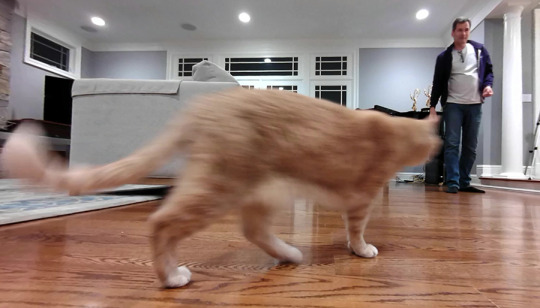
Stills you pull out of the Clips’s videos are often motion-blurry.
Use the app’s own AI to choose a subset of the captures — the “winners” — automatically.
Adjust settings so that the camera captures shots with greater or lower frequency.
The app is really well done. The actual photos are another story.
What you get
Despite the cool idea of an AI camera, the results are disappointing.
The photos don’t look as good as your phone’s. In low light, they’re grainy; indoors, there’s often motion blur.
The camera has a fixed-focus, very wide-angle (130-degrees) lens. As a result, anything closer than three feet is out of focus, and anything farther than eight feet looks really tiny. And anything near the edge of the frame gets bizarrely stretched and distorted.

Note to craniofacial surgeons: There’s nothing wrong with Cody’s head. That’s just something the Clips camera does.
But the bigger issue is that the AI doesn’t work especially well. It captures things, all right, but I’m not sure that its artificial intelligence is any match for your intelligence.
I spent a morning with my adorable five-month-old friend Cody and his mom Lauren. The Clips caught plenty of cute clips — but not always the great ones. At one point, Cody managed to flip himself from back to front. “Good job!” his mom exclaimed. “Did it record that?” she asked me.
No, it did not.
At my own house, I love tossing cat treats for Wilbur the Wonder Cat. He bounds across the slippery floors, chasing it like a cat out of hell, and then pounces on the treat, skidding hilariously three or four feet. I set up the Clips at the right spot for the landing and tossed the treat on target over and over again. The Clips couldn’t get the Wilburdive.
Then there’s also the central concept of trusting the capture. Yes, it’s AI, but what does that mean?
Google says that the camera is waiting for the right combination of lighting, composition, and smiling faces. But do you want photos (or silent video clips) only of the happy moments in your life? Is it possible that you might sometimes want to capture an unhappy moment — say, the tragicomic moment when your 4-year-old’s ice-cream scoop falls off its cone? Google’s AI won’t capture that. (The company says that it plans to offer preference settings for emotional tone in a future update.)
I love the idea of a camera that uses AI to capture the good stuff all by itself. And I do love the freshness of the angles and positions that the Clips’s clip permits.

You can pop the Clips camera into places and angles where your phone would never work.
I just don’t think that much of the Clips’s clips.
You’re paying $250 for a camera that can’t directly take stills and can’t capture video with sound. It doesn’t work as an “ambient camera,” like a security camera that’s rolling all the time. It doesn’t work as a GoPro-type camera, either; its super wide angle means that if it’s clipped to, for example, your body, the video is unwatchably jerky. And its AI-only sort of works.
I’m glad that Google did the Clips experiment, because there are some really good ideas here, and real-world problems to be solved. I just don’t think you should buy it.
David Pogue, tech columnist for Yahoo Finance, welcomes non-toxic comments in the Comments below. On the Web, he’s davidpogue.com. On Twitter, he’s @pogue. On email, he’s [email protected]. You can sign up to get his stuff by email, here.
Read more
Why I bought Honda’s plug-in hybrid mystery car
Apple’s HomePod speaker: Either way late or way early
The tiny, 4K Mavic Air crushes other DJI drones
#_uuid:b22051ee-f9ba-3477-bef6-32ecd67d58c1#Google#Pogue#_lmsid:a077000000BAh3wAAD#$GOOGL#_revsp:yahoofinance.com#$GOOG#video#Google Clips#_author:David Pogue
1 note
·
View note
Text
The Pogie Awards: The best ideas in tech of 2017
yahoo
Good evening, ladies and gentlemen! Please find your seats and silence your phones… it’s time now for the 13th annual Pogie Awards!
To be clear: These awards don’t go to the best products of the year. You really don’t need another one of those articles.
These are awards for the best feature ideas within products—even if the products themselves aren’t so hot. The point is to celebrate the inspiration that struck some designer or engineer—and to hail that idea’s successful journey out of committee, past the lawyers, and into the hands of the public.
So what were the best ideas in tech of 2017?
The Safety With Numbers Award
This new feature in iOS 11 could save your bacon—or your life. It’s called Emergency SOS.
Once you’ve set it up, it works like this: If you ever feel that you’re in danger—walking down the street, or someone’s assaulting you, or you’ve been in an accident—you click the power button five times fast. You can even do that in your pocket without looking at the phone.
After a 3-second countdown, it automatically dials 911 … texts anyone you’ve setup in the Settings, letting them know you’re in danger and showing where you are … and starts a loud whooping alarm, to rattle whoever’s bothering you.

The new Emergency SOS feature of iOS 11 is always there if you need it.
Just knowing that your phone is an emergency beacon can give you a little boost of confidence—and a big boost of safety.
A New UI for You and I Award
The public wants bigger screens on their phones, and also wants more features every year. But if you’re the manufacturer, it’s hard to expand the screen without taking away buttons.
But HTC’s U11 phone introduces a new form of user-interface that adds features without adding buttons: Squeezing the sides. Since you’re already holding the phone with your hand wrapped around the sides, it’s a natural, one-handed, useful move.

The HTC U11 is squeezably good.
You decide what that action does. It can open the camera app, bring up the Google Assistant, turn on the flashlight, take a screenshot, start a voice recording, ask a question of Alexa, or turn the personal hotspot on or off, for example. You can also make a short squeeze and a long one do different things.
Google (GOOG, GOOGL) has now added that same idea to its Pixel 2 phones; looks like it’s a good idea catching on.
The Cut Cord Award
At this point, tens of millions of us own voice-assistant speakers, like Alexa on the Amazon (AMZN) Echo, or OK Google on the Google Home. But this year, both companies added a killer idea: free phone calls. To regular phone numbers.
Without budging from the couch, you can say, “Alexa, call Casey’s cellphone,” or “OK Google, call mom,” and boom—free speakerphone call. Free as in hands-free, and free as in, the calls are free.

Free phone calls? We’ll take it.
The Massive Transportation Award
OurBus gives power to the people—by letting the people crowdsource new commuter bus routes.
The buses are luxury liners, with power and WiFi at every deluxe, reclining seat. (OurBus doesn’t actually own any buses. It supplies only the technology and software to existing bus companies—usually charter bus companies whose buses aren’t being used to their full capacity.) If you can find 100 people who’d be interested in a certain bus route, they’ll put it together.

OurBus crowdsources commuter bus routes.
The Pedal Wins a Medal Award
Buses aren’t the only way to get around without choking up the air and the roads. Bikes are free to ride, free to park, great exercise, and they never get stuck in traffic. Too bad you show up at work panting and sweaty.
Electric bikes are all the rage in Europe, but the nice ones are very expensive. But suppose you could electrify the bike you already have? Suppose you could just pop off its wheel, and replace it with a motorized one—without giving up the frame, seat, brakes, gears, and handlebars you already own and love?
That’s where the Copenhagen Wheel comes in. It replaces the rear wheel of your existing bike.
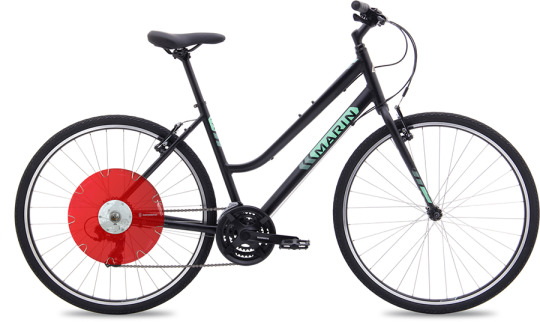
The Copenhagen Wheel electrifies your existing bike.
It’s a beautiful, compact, simple-looking machine. There’s nothing on your handlebar, no cable snaking up your bike frame. Instead, the shiny red capsule hub of your wheel contains everything: motor, battery, circuitry, and 74 sensors.
When you start to pedal, the Wheel amplifies the power of your foot. The boost is smooth, silent, and controlled, and the feeling is exhilarating. Everyone who tries it utters one delighted exclamation or another: “WOOHOO!!” or “Whoa!” or “Oh, wow!” or “Omigod!”
The huge benefit of replacing your rear wheel is, of course, that the Wheel knows when you’re pedaling, and how hard. It gives you a boost proportional to the effort you’re expending.
The Stick It in Your Ear Award
Like it or not, the smartphone headphone jack is gradually going away. It’s gone from Apple’s phones, Google’s phones, HTC’s phones. We’ve entered the age of wireless earbuds.
Apple’s AirPods look bizarre, because of that little stick, and because they’re completely detached. (The Airpods technically went on sale in December 2016, but the idea behind them really took off this year.) The beauty is that you can pull out just one when you need a quick listen—some phone call, some Facebook video—and then pop it right back into the charging case.

The AirPods are completely detached, making them quicker to put on and off.
You may love the AirPods or you may hate them, but the idea here—two completely detached earbuds—puts them into a new realm of instant access. (It also means double the battery life, because each earbud plays for 5 hours on a charge.)
The Pogie Ultimo
And finally, we come to our biggest award of the evening: The Pogie Ultimo!
The one idea that has the most potential to improve the lives of the downtrodden technology-using masses with a single, ingenious stroke. And that award goes to: the MoviePass card.
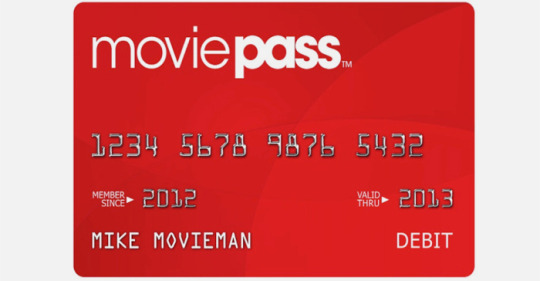
The MoviePass card gets you into movie theaters every day—for $10 a month, flat fee.
It’s like Netflix for movie theaters. You pay a flat 10 bucks a month, and for that flat fee, you can go out to the movies all you want! A movie every day, if you want. But with movie tickets at $15 in cities, even if you see one movie a month, you’re coming out ahead.
Movie Pass buys you a ticket at full price, so the theaters don’t lose out, either. (MoviePass says that it will make money by selling the data it collects about its customers—anonymized, of course.)
The only footnote is that 3D and IMAX movies aren’t included. But otherwise, this is the deal—and the idea—of the year!
Happy New Year
And there you have it, folks—the 2017 Pogie Awards. Let these bursts of inspiration show you that even products that are turkeys… sometimes harbor a little bit of gravy. Good night, everyone—and happy New Year!
More from David Pogue:
Royal Caribbean’s big bet on new tech
Battle of the 4K streaming boxes: Apple, Google, Amazon, and Roku
iPhone X review: Gorgeous, pricey, and worth it
Inside the Amazon company that’s even bigger than Amazon
The $50 Google Home Mini vs. the $50 Amazon Echo Dot — who wins?
The Fitbit Ionic doesn’t quite deserve the term ‘smartwatch’
Augmented reality? Pogue checks out 7 of the first iPhone AR apps
David Pogue, tech columnist for Yahoo Finance, is the author of “iPhone: The Missing Manual.” He welcomes nontoxic comments in the comments section below. On the web, he’s davidpogue.com. On Twitter, he’s @pogue. On email, he’s [email protected]. You can read all his articles here, or you can sign up to get his columns by email.
#Pogue#David Pogue#_lmsid:a077000000BAh3wAAD#$GOOGL#_uuid:b4edfa56-6d93-33c7-8773-7bf850c0df24#_revsp:yahoofinance.com#$GOOG#$AAPL#_author:David Pogue#$AMZN
4 notes
·
View notes
Text
Pogue's cheap and unexpected gifts: the Soi Handbag Light
yahoo
Each week until Christmas, I’ll be back on Yahoo Finance’s “Midday Movers” to recommend another holiday tech-gift idea—always cool, cheap, and unexpected!
At a folk festival a few years ago, German engineers Christian Schech and Bastian Wetzel noticed how the women tried to illuminate their purses and handbags when they wanted to find things in there—by turning on their phone flashlights or even lighting their lighters. And a light bulb (heh) went off.
They’ve now invented the Soi Handbag Light ($30). I have no idea what Soi is supposed to mean (is it a typo for SOL?), but the idea is great: It’s a three-inch, featureless flying saucer that you keep in your purse, laptop bag, or backpack. Then, whenever you start rooting around in there, a bright white LED light bathes the proceedings so you can see what you’re doing.

In the depths of your darkened bag, all is illuminated.
Everyday jostling doesn’t turn it on; it lights up only when it senses the proximity of your hand. At that point, the light comes on for about 10 seconds. It’s powered by a pair of AAA batteries, which the company says lasts for 6,000 bag-foragings.

The Soi bag light has no controls or buttons; the presence of your hand turns it on.
I think the company does itself a disservice by marketing the Soi exclusively to women for their handbags; I’ve tossed one into my Timbuk2 laptop bag and life has never been the same. For starters, since you’re not clutching a phone or a lighter, you now have both hands free to do your exploration.
If there’s a better candidate for the cheap and unexpected high-tech gift idea, I haven’t seen it.
More from David Pogue:
Battle of the 4K streaming boxes: Apple, Google, Amazon, and Roku
iPhone X review: Gorgeous, pricey, and worth it
Inside the Amazon company that’s even bigger than Amazon
The $50 Google Home Mini vs. the $50 Amazon Echo Dot — who wins?
The Fitbit Ionic doesn’t quite deserve the term ‘smartwatch’
Augmented reality? Pogue checks out 7 of the first iPhone AR apps
David Pogue, tech columnist for Yahoo Finance, is the author of “iPhone: The Missing Manual.” He welcomes nontoxic comments in the comments section below. On the web, he’s davidpogue.com. On Twitter, he’s @pogue. On email, he’s [email protected]. You can read all his articles here, or you can sign up to get his columns by email.
#tech#_uuid:33e5426a-5626-3627-b33c-dab5f990077a#Pogue#David Pogue#_lmsid:a077000000BAh3wAAD#_revsp:yahoofinance.com#_author:David Pogue
9 notes
·
View notes
Text
Look up! A dozen 'air taxi' flying cars are readying for takeoff
yahoo
Well, it may have been 56 years since “The Jetsons” was first on TV, but flying cars are finally about to become real.
The last few months have been filled with news of companies that unveiled, demonstrated, or released videos of their “air taxis,” as they’re often called. They’re basically giant-sized versions of drones — giant enough to carry a person, or two, or five.
Why now? Because all the necessary ingredients have aligned: Batteries with high enough energy density to carry these copters into the air; composite materials like carbon fiber light enough to work; avionics (aircraft software and electronics, developed for regular drones) cheap and reliable enough to adapt; and collision-avoidance systems advanced enough to keep these things from crashing.
The beauty of these personal copters is that since they’re all electric, they’re really quiet. They could fly at low altitude without becoming a nuisance to people on the ground. And, of course, they’re pollution-free: zero emissions.
All of these models can be autonomous. You plug in your destination, and the thing flies you there. Some have a joystick so that you can seize control of it if you want, and most can also be remote controlled.
These air taxis are built with redundancies of the major elements, so even if something goes wrong, you won’t drop out of the air. Many have low-altitude parachutes, too.
Now, don’t get all excited. You can’t buy a passenger drone yet — that moment will probably come in 2020 at the earliest, and they’ll cost hundreds of thousands apiece. Even then, nothing will happen in the U.S. until the Federal Aviation Administration comes up with rules to govern how these things use the airspace.
Oh, and by the way: Even with all the advances in batteries and materials, these things are still super limited in flight time. You’re lucky to get 20 minutes in the air.
But the trend is unmistakable: A lot of companies have working prototypes that are taking real people on real flights.
Who’s taking off first?
Here are some of the flying machines that have surfaced recently:
eHang 184
This Chinese drone maker has been working on the eHang air taxi for four years, and it’s fairly far along. Since the capsule holds only one person, it’s small — about the size of a car. The prototype has made over 1,000 tests in China, sometimes in high winds and at even at night.
youtube
Here are the specs:
10-mile range
80 mph top speed
Partnered with the Dubai government, who wants to develop air taxis to service its cities
Lands automatically in case of a malfunction
A two-passenger model is on the drawing board.
Volocopter
One of the highlights of CES 2018 was watching this gigantic, 18-rotor craft land on the stage during Intel’s keynote presentation. (Also at CES: The Volocopter’s first passenger was Intel’s CEO, Brian Krzanich.)
youtube
The details:
Designed and built in Germany, where it has approval to fly
Autonomous, joystick-operated, or remote controlled
Carries two passengers
18 rotors, parachute
70mph cruising, 17-mile range
Conducting test flights in Dubai
Estimated price $300,000
Passenger Drone
Weirdly enough, this California passenger-drone company is called Passenger Drone, and so is its product — the Passenger Drone. It carried its first passenger in November.
youtube
16 rotors on 8 spindles
Autonomous, joystick-operated, or remote controlled
Carries two passengers
Top speed: 45 mph
25 minutes per charge
20-minute flight time
Joby
This copter is the brainchild of JoeBen Bevirt, who made his fortune from selling — I kid you not —flexible-arm GorillaPod camera tripods. Now, with the help of $100 million in investments from Toyota, JetBlue Technology Ventures, and Intel, it’s preparing a sleek VTOL (vertical takeoff and landing) copter that can carry four passengers and a pilot for 150 miles. (Full disclosure: My wife does PR work for JetBlue Tech Ventures.)
A couple of weeks ago, Joby invited a pair of Bloomberg reporters to witness an unmanned flight. They weren’t allowed to take pictures or even describe the thing, which is a bummer. But they watched it fly, remote controlled, for a 15-minute flight. “Bevirt says thousands of these sky cabs will one day shuttle people around cities, soaring above the conventional traffic below,” goes the article.
Vahana
This prototype, developed by European plane maker AirBus, has propellers that point upward for takeoff, like a helicopter’s, and then rotate forward, like a plane’s. The company flew it, unmanned, for the first time last month.
youtube
Details are sketchy — they don’t even have a website (only a blog) — but here’s what we know:
Single-passenger
“Productzable prototype” in 2020
Parachute
Illium
Unlike most air taxis, which are propeller planes, this one is an electric jet with a 180-mile range.
Here’s the video of its maiden (unmanned) flight:
youtube
The bullet points:
Holds two people
180-mile range
275 mph
Vertical take-off and landing
First manned flight planned for 2019; on-demand flights by 2025
Based in Germany
And the rest
Just about any deep-pocketed company who’s anyone is diving in. For example:
Uber Elevate, its self-driving air taxis, are nothing more than a white paper and a killer CGI video at this point. But clearly, they’re all in on the concept; they expect to launch the air-taxi service within a decade.
youtube
Boeing bought Aurora Flight Services, maker of VTOL planes, in hopes of exploring the air-taxi concept.
Larry Page, CEO of Alphabet, has spent $100 million to fund two electric-craft companies. There’s Zee.Aero, which has prototypes for two VTOL electric passenger planes, and Kitty Hawk, which is making a no-license-required personal hovercraft for use over water.
youtube
Zunum Aero is working on electric versions of traditional passenger jets (700-mile range).

The Zunum Aero will be an all-electric jet.
We know this much about technology and disruptive change: Everything takes longer than we think, everything has unintended consequences, and everything’s subject to government regulation.
But with this much money and so many companies all chasing this dream, it seems likely that air taxis really will take off — at some point.
David Pogue, tech columnist for Yahoo Finance, welcomes non-toxic comments in the Comments below. On the Web, he’s davidpogue.com. On Twitter, he’s @pogue. On email, he’s [email protected]. You can sign up to get his stuff by email, here.
#_uuid:8b90750a-d22e-3602-8656-310bd90e2141#_lmsid:a077000000BAh3wAAD#_revsp:yahoofinance.com#_author:David Pogue
1 note
·
View note
Text
Algorithmic trading caused the flash crash: An explainer
yahoo
On Monday, the stock market did something weird. Sure, it was sinking through the day — but then, at about 3 p.m. ET, it plummeted. Nobody could figure out why. There was no big headline, no sudden announcement.
“The drop in the morning was caused by humans, but the free-fall in the afternoon was caused by the machines,” wealth manager Walter “Bucky” Hellwig told Bloomberg.
Hup — there it is. Algorithmic trading caused the flash crash.
My “Midday Movers” producer asked me to offer an explainer for “algo trading,” as it’s nicknamed —but really, it’s not hard to grasp. Algo is when you program software to buy or sell stocks automatically, based on timing, price, quantity, or some mathematical model.
Algorithmic trading has a number of benefits: It rules out human emotion; it places trades instantly and precisely, locking in at the values you want; and lets institutional investors (like mutual funds and insurance companies) buy or sell huge quantities of stock in many smaller blocks, so as not to affect the stock price in the process.
Algo trading also, however, tends to magnify upward or downward trends, as we saw yesterday. Fortunately, the market largely recovered after the algo-driven selloff — maybe because humans came back to their desks.
David Pogue, tech columnist for Yahoo Finance, welcomes non-toxic comments in the Comments below. On the Web, he’s davidpogue.com. On Twitter, he’s @pogue. On email, he’s [email protected]. You can sign up to get his stuff by email, here.
#_uuid:e256710f-52cf-3b03-9457-a82275caa671#_lmsid:a077000000BAh3wAAD#_revsp:yahoofinance.com#_author:David Pogue
1 note
·
View note
Text
Exclusive: What Fitbit's 6 billion nights of sleep data reveals about us
yahoo
How we sleep is unbelievably important. Getting too little sleep not only makes you feel lousy and cranky, but it’s also linked to obesity, diabetes, hypertension, and even early death. (No pressure.)
But it’s amazingly hard to measure our sleep, as a population. Sure, one person at a time can stay overnight at a sleep lab, hooked up to scalp electrodes — but try sleeping normally that way, away from home and wired to strange equipment. Other sleep studies use self-reporting, where you write down each morning how you slept, but that data is famously unreliable.
Now, though, there’s a new way to study our sleep: Fitness bands, worn by millions of people. Most of Fitibit’s bands, for example, have built-in heart-rate monitors, which produce much more accurate sleep-measurement results than earlier bands. These bands track your sleep automatically, in your own bed, on your normal schedule, under normal conditions.
Since Fitbit began tracking sleep stages in March 2017, it has collected data from 6 billion nights of its customers’ sleep. This is a gold mine — by far the largest set of sleep data ever assembled. (This data is anonymous and averaged; it’s not associated with individual customers’ names.)
“It’s a really, really exciting and really rare data set,” Fitbit data scientist Karla Gleichauf says. “It’s probably the largest biometric data set in the world.”
The measurements include not just how long you sleep, but what stages of sleep you experience. Each morning, the Fitbit app shows which parts of the night you spent in REM sleep (the vivid-dreams stage, good for mood regulation and memory processing), in deep sleep (good for memory, learning, the immune system, and feeling rested), in light sleep, and awake. (It’s always disheartening to see how much of the night you waste in little one- or two-minute wake-ups that you don’t even remember.)

Each morning, the Fitbit app shows how you slept.
But wait, there’s more. The Fitbit app also knows your gender, age, weight, height, location, and activity level. Therefore, the company’s data scientists can slice and dice its massive sleep database in fantastic ways. They should be able to tell us who sleeps more: men or women. Northerners or Southerners. East Coasters or West Coasters. They should be able to calculate our national average bedtime. They should be able to draw all kinds of conclusions about the way we sleep — and what’s good for us.
Now, for the first time, they have. Gleichauf and her boss, Conor Heneghan, Fitbit’s lead sleep research scientist, agreed to mine that vast sleep database to unearth some of its secrets. Some of their findings reinforce what sleep scientists have already studied; some have never been measured before.
Here’s what Fitbit discovered — a Yahoo Finance exclusive.
Men vs. women
Women sleep 25 minutes longer a night than men. They average six hours and 50 minutes of sleep a night, whereas men get only six hours and 26 minutes. Neither group gets anywhere close to the recommended eight hours a night.
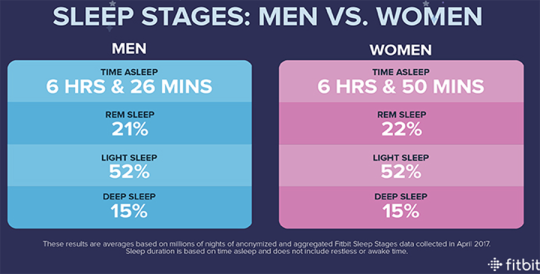
Women get about 25 minutes more sleep a night than men.
Women also get about 10 minutes more REM sleep than men every night, too — a gap that widens after age 50.
Why these differences? “It’s really not known if it’s a physiology thing, is it a cultural thing, who knows,” Heneghan says. “I think that would be super exciting over the next 10, 20 years for people to really get into why.”
The news for women isn’t all good, though: They’re 40% more likely to suffer from insomnia — trouble falling asleep — than men.
(Those two findings could be related, too: Since women’s sleep is less efficient, they have to spend more time in bed.)
Old vs. young
Getting older also affects your sleep. In this graph from Fitbit’s sleep study, you can see that we get less deep sleep as we age. When you’re 20, you’re getting half an hour more deep sleep a night than when you’re 70.

We get less and less of the good sleep as we age.
North vs. South
Yes, it’s true: Northerners go to bed five minutes earlier than Southerners. They wake up earlier, too.
That may seem like a very small difference, but on the scale of billions of data points, it’s significant.
On the other hand, Heneghan points out that statistics can be tricky. “I think North/South may be an artificial divide; urban/rural is probably a more meaningful divide,” he notes. In other words, there may just be more big cities in the North.
East vs. West
East Coasters, according to the data, stay up seven minutes later than West Coasters (and wake up five minutes later, too).
“I personally find this consistent with my experience of American culture,” Heneghan says. “I lived in New York. I lived in California. You get to 9 p.m. here in California, and the restaurant staff are kind of looking at you funny. There’s a great quote from Yogi Berra: ‘It gets late real early around here.’”
The national bedtime
Here’s a data point that no amount of sleep-lab studies could have unearthed: The average American goes to bed at 11:21 p.m.
Bedtime consistency
The biggest finding in Fitbit’s data may be the link between sleep quality and bedtime consistency.
That, Gleichauf explains, “is this idea that your bedtime varies.”
And in America, it really does vary — by an average of 64 minutes. You might go to bed at 11 p.m. on weeknights, but stay up after midnight on the weekends.
The Fitbit data shows that your sleep suffers as a result. If your bedtime varies by two hours over the week, you’ll average half hour of sleep a night less than someone whose bedtime varies by only 30 minutes.
And you’ll pay the price.
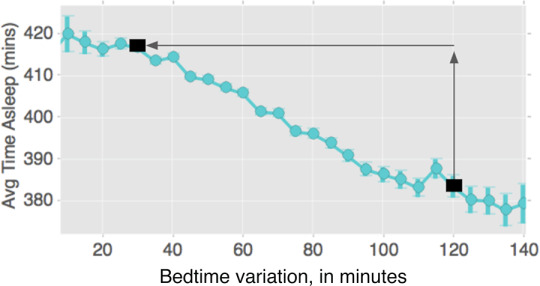
By the time your weekly bedtime variation is 2 hours, it’s costing you half an hour of sleep a night.
You know how jet lag works, right? “When you have jet lag, it’s the mismatch between the actual time, in the zone you’re in, and your circadian rhythm,” Gleichauf told me. “You’re not on the right part of that curve to make you fall asleep.” So, at night in your new city, you lie there for hours, unable to fall asleep — and then in the middle of the next day, you’re overcome by exhaustion.
When your bedtime varies over the week, then, you’re creating self-induced jet lag. Gleichauf calls it social jet lag: On Monday, when you have to go back to work (and drag your bedtime backward), you feel crummy and you’re more likely to get sick.
(Dr. Till Roenneberg, professor at the Institute of Medical Psychology at the University of Munich, calculates that every hour of social jetlag increases your risk of being overweight or obese by about 33%.)
“I’m super excited about this data,” Heneghan says. “For the first time ever, we were actually able to show the link between consistency and how long you sleep.”
Social jet lag, by city
Gleichauf dove into American geography to see if there were differences in bedtime consistency — and there is.
Can you guess which city has the most widely varying bedtimes over the week?
It’s Boston — probably because it’s a huge college town, with a huge population of young people.
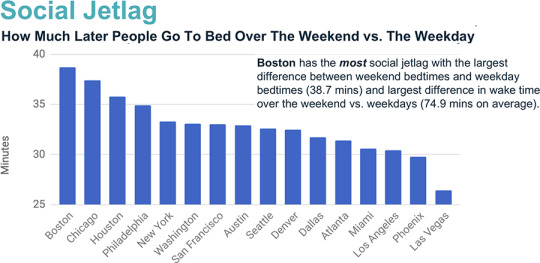
Congratulations, Boston—you have the most erratic bedtimes in the country.
Can you guess which one has the least variation in bedtimes?
It’s Las Vegas. “People who live and work in Las Vegas — if they’re in the industry of nightclubs and casinos, their schedule is going to be much less weekend-dominated,” Heneghan says.
Wake-up times also vary. This time, Seattle is the winner, with the least variation across the week. The losers here are New Yorkers, whose wake-up times swing an average of 73 minutes over the week. (Well, it is the city that never sleeps.)

New York is the city that never wakes up consistently.
The takeaways
The reporting that Fitbit’s sleep scientists offer in this exploration is only the very, very beginning. The company has amassed big data — big sleep data — that could provide some incredible answers. We just have to ask the right questions.
Why do men and women sleep differently? Why do we get less deep sleep as we age? Beyond the “party on the weekend” effect, why do our bedtimes vary so much? We know that exercise is good for our sleep, but when should we exercise for the best sleep? When should we eat if we want to get the most deepest sleep? Is the kind of sleep (REM sleep, deep sleep) more important than the total time asleep? Should the nation’s school hours and work hours be adjusted to fit the way we actually sleep?
Fortunately, Fitbit plans to share its data, both with other scientific institutions and in science journals; it’s thrilling to think of the new knowledge that may result from it.
Until then, consider trying to get to bed at a more consistent hour throughout the week. You’ll sleep better, you’ll sleep longer, and you’ll feel better once you’re up.
Or just move to Las Vegas.
David Pogue, tech columnist for Yahoo Finance, welcomes non-toxic comments in the Comments below. On the Web, he’s davidpogue.com. On Twitter, he’s @pogue. On email, he’s [email protected]. You can sign up to get his stuff by email.
Read more:
Tech that can help you keep your New Year’s resolutions
Pogue’s holiday picks: 8 cool, surprising tech gifts
Google’s Pixel Buds: Wireless earbuds for the extremely tolerant
Study finds you tend to break your old iPhone when a new one comes out
Rejoice: Sonos Speakers are finally voice-controllable
#sleep#_uuid:1b18e117-49dc-3035-a0e6-05b932100f3c#_lmsid:a077000000BAh3wAAD#pogue#_revsp:yahoofinance.com#_draft:true#$FIT#Fitbit#_author:David Pogue
2 notes
·
View notes
Text
DJI to unveil a pocket-size, foldable drone
yahoo
DJI is the 800-pound gorilla of the drone world. At this point, every time the Chinese company introduces a new drone, it’s basically cannibalizing sales of its own existing products.
Never will that become more true than next week, when its new Mavic Air drone is unveiled. Far smaller than the older Mavic Pro, the Air folds up small enough to fit into a coat pocket — its most important feature by far.
But the Mavic Air is less expensive, too ($800 including remote controller), yet still does 4K video capture from a camera that’s on a 3-axis gimbal (meaning super-stable video). The Air has sensors on the back, so that it can avoid collisions, either forward or backward.
You can control the Air with hand motions, just as you can the $400, non-folding, equally small DJI Spark. In fact, you can use even more motions.
On the Spark, those “use the force” hand gestures were iffy. Sometimes, the drone just looked at you dumbly no matter how spastically you did the gestures. When I review the new Air next week, I’ll see if DJI has managed to improve that feature.
In the meantime, on paper, anyway, the Mavic Air is one juicy semi-pro drone indeed!
—
David Pogue, tech columnist for Yahoo Finance, welcomes non-toxic comments in the Comments below. On the Web, he’s davidpogue.com. On Twitter, he’s @pogue. On email, he’s [email protected]. You can sign up to get his stuff by email, here.
Read more:
Exclusive: What Fitbit’s 6 billion nights of sleep data reveals about us
Tech that can help you keep your New Year’s resolutions
Pogue’s holiday picks: 8 cool, surprising tech gifts
Google’s Pixel Buds: Wireless earbuds for the extremely tolerant
Study finds you tend to break your old iPhone when a new one comes out
Rejoice: Sonos Speakers are finally voice-controllable
Follow Yahoo Finance on Facebook, Twitter, Instagram, and LinkedIn
#DJI#_uuid:ff14f0a5-ba5f-3fc6-85ee-257b3aaf9df6#Pogue#_lmsid:a077000000BAh3wAAD#_revsp:yahoofinance.com#_author:David Pogue#drone
1 note
·
View note
Text
Inside the Amazon company that's even bigger than Amazon.com
yahoo
Everybody knows what “the cloud” is, right? It’s, like, internet storage or something? Sure. Yeah.
I wanted to go a little deeper. I wanted to know exactly what it is, where it is, who owns it, who runs it, and how it works. So I did a little travel, conducted some interviews—and last Sunday, “CBS Sunday Morning” aired my story. You can watch it here.
The “who runs it” part has a particularly interesting answer. In large part, the answer to that is, “Amazon” (AMZN).
Over the last decade, Amazon has quietly built up the world’s largest cloud-services company, called AWS (Amazon Web Services). In terms of income and profit, it’s much bigger than Amazon.com (the division that sells stuff by mail-order).
It’s also much bigger than its rivals, which include Microsoft (MSFT), IBM (IBM), and Google (GOOG, GOOGL); in fact, AWS says that it’s bigger than its next 14 competitors combined.
Most companies don’t like to reveal what cloud-services company they use, but here are a few companies that don’t mind saying that they run on AWS: Hulu, Netflix, Comcast, Spotify, Pinterest, Yelp, Airbnb, Slack, PBS, SmugMug, Hertz, Time, Intuit, Unilever, Zillow, Dow Jones, Morningstar, Under Armour, Kellogg’s, Expedia, Adobe, Philips, GE, Shell, AOL, BMW, Canon, Capital One, IMDb, Johnson & Johnson, Lamborghini, Lyft, McDonald’s, NASA, Novartis, Pfizer, Philips, Samsung, SAP, Sony, SoundCloud, Ticketmaster, and the US Department of State.
For the TV story, I had the rare opportunity to interview an Amazon executive: Dr. Matt Wood. His current title is general manager for artificial intelligence AWS, but he’s been part of AWS from the beginning. (I asked him if the “Dr.” meant medical doctor or PhD doctor. In Wood’s case, both. He started his career as a medical doctor.)
As always happens, though, the time constraints of TV meant that not all of the good stuff from our interview made it into the broadcast. So here, for your reading pleasure, is a more complete edited transcript of my interview with Dr. Wood.
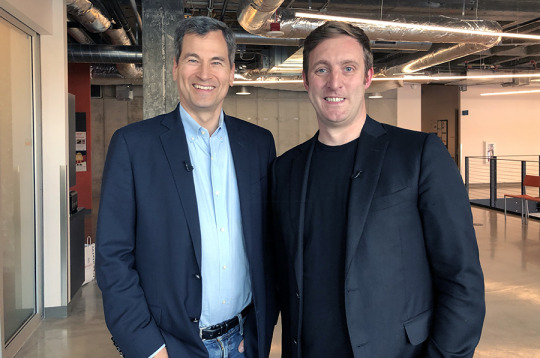
Dr. Matt Wood (right) joined me for a “CBS Sunday Morning” interview at Amazon’s Seattle headquarters.
POGUE: Because AWS caters to businesses, not ordinary consumers, most consumers haven’t heard of it. But it’s giant, right?
WOOD: It’s a relatively large business today. We’re a little over $16 billion in revenue run rate [projected income for 2017], and we’re growing at just over 40% a year.
POGUE: So who had the foresight, when AWS started, to say, “You know what could be really a good business for us…?”
WOOD: It actually came out of Amazon retail. The developers inside Amazon retail wanted to be able to move more quickly. They were frustrated about having to write big checks [to buy new server equipment] and wait and wait and wait [for them to be delivered], and do all this extra work to be able to try out their idea.
And so we started to come up with some ideas about how we could make that faster. And so we started to explore an entirely new business for us, selling these services to businesses in the same way as Amazon was consuming them.
POGUE: So all of these companies are hiring AWS to do what?
WOOD: They are able to pull down computational power as if it was a utility.
So let’s say you’re a brewery, right? They don’t want to manage computers. They want to brew beer. They don’t want to be going through the expense and the upfront cost and all the complexity of managing these large amounts of computers.
POGUE: So it sounds like cloud companies like AWS are basically renting computers, storage, power, security—all the stuff that technicians would have normally had to do on site, right?
WOOD: That’s right, yes.

AWS is relatively unknown to consumers—but it’s by far the largest piece of Amazon.
POGUE: Are you also saying there was a time before cloud companies when people did all this stuff in house?
WOOD: Yeah. People often talk about the “heavy lifting” of building web applications or mobile applications. Well, back when I was doing my Ph.D., we were given the task—a group of Ph.D. students—to move a mainframe computer from one room to another.
This thing weighed — it must have been several tons. It took about eight wimpy nerds to try to lift it. We dropped it, and it got stuck in the doorway. (LAUGH) We had to get the university football team to come in and help us move it out of the way before our professors came back and found us!
POGUE: (Laugh) Literal heavy lifting!
WOOD: So it’s not like that today. All I need is an AWS account and a credit card, and I can start trying out new ideas, for pennies.
And larger organizations find the same benefits. And so today, very large organizations such as, you know, GE, Shell, Phillips, Netflix, all run on top of AWS.
POGUE: Really? Netflix?
WOOD: Yes.
POGUE: Wait. Amazon has a very similar business—Amazon Prime Video. Why would Netflix hire its arch-rival to store and serve up its movies?
WOOD: Well, that’s a good question. It’s one that Netflix asked us very early on. (LAUGH) From the very first day of AWS, we set up the company as a separate business. We have a separate management chain; we are situated in a separate building.
We even wanted companies that could potentially compete with Amazon.com—our cousins at retail—to be able to use the same platform. And so to AWS, Amazon.com is just another customer.
POGUE: Is there a downside to the cloud idea? Is there any reason that somebody might shy away from structuring their data this way?
WOOD: The only reason I can really think of is that some companies have already made those very, very large investments in their own data centers. They’ve signed the checks, they’ve done the waiting, they’ve racked and stacked their service. And so they’ve already made that investment.
POGUE: So suppose I’m one of these companies who’s got an existing computer setup, and I want to move to AWS…
WOOD: Yeah. There’s a couple of ways that you can do that. You can just upload it as normal. But sometimes you have so much data [that it would take forever to transmit electronically]. So we built this device–the Snowball.
(He shows me a suitcase-size, gray, plastic-enclosed case.)
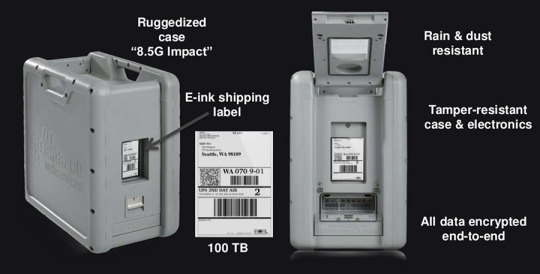
The AWS Snowball can be a faster, cheaper way to send a company’s data to Amazon than uploading it.
POGUE: Snowball, you call it?
WOOD: It’s 100 terabytes of storage. And you just connect this up to your data center, load your data on. And then you just physically ship it back to us, and then we load it into the cloud from our data center.
POGUE: Ship it, like through FedEx or UPS or something—
WOOD: Exactly. You should never underestimate the bandwidth of a FedEx truck. (LAUGH) In fact, right on the front here, you can see that we have an e-ink display—basically, a Kindle—which shows the customer’s address when we ship it out to them. And then as soon as they arrive and plug it in, [the address on that screen changes to show] our data center collection location, and you just ship it back to us.
POGUE: Oh, this—this is a screen, this is not paper—
WOOD: Exactly, yes. Because we didn’t want the shipping labels to come off in transit.
POGUE: So essentially, this is like a giant shippable hard drive. Can you track it?
WOOD: Yeah; it has 3G, Wifi, and also a GPS system.
POGUE: But hard drives are delicate. What if the shipper guy drops it?
WOOD: We built them to be robust and ruggedized. We actually built them to military specifications. We put them on a boat in the middle of a lake and then exploded depth charges around the boat and then made sure they could still work.
POGUE: Can it handle a drop to concrete?
WOOD: Easily, no worries.
POGUE: Like this? (I shoved the Snowball off the table onto the concrete floor, where it just bounced and then lay flat) It’s okay, folks! It doesn’t have a scratch on it. I don’t know about the floor, though.
WOOD: (LAUGHS)
How AWS handles security
POGUE: OK, we gotta talk about security. I imagine you have a huge staff of experts?
WOOD: Yeah. I mean, security really is job zero for us. We take it extremely seriously. It’s the first thing that we think about when we get up in the morning, it’s the last thing we think about when we go to bed.
POGUE: Because “the cloud” actually resides in data centers—huge, unmarked buildings running thousands of servers. And one AWS data center may house the livelihoods of a bunch of companies, all concentrated in one building.
WOOD: Actually, we don’t even store all of the data in one place. We don’t have a single data center. We use groups of data centers. And those groups of data centers are separated by large distances. They’re on separate floodplains and fault lines. We move data automatically between the data centers in those groups. And that means the data is always backed up, not just inside a data center or between data centers, but between groups of data centers in different physical locations.
POGUE: So I don’t mean to give anyone ideas, but let’s say I figured out that one of these unmarked buildings was an AWS data center, and I blew it up. Are you saying that it’s so backed up and redundant that you probably wouldn’t notice?
WOOD: Yeah, you wouldn’t notice. I mean, we might be a bit upset, but you wouldn’t notice.
POGUE: That leads into my other question, which is that 70% of the cloud, 70% of the world’s internet traffic, flows through data centers in Loudoun County, Virginia. Should we be worried about that concentration?

70 percent of the world’s Internet data flows through the massive data centers in Loudon County, Virginia. (CBS News)
WOOD: No, that data is backed up across multiple different physical locations. And we do that to limit the blast radius. If something does happen, or we have a power event, or there’s a flood in one specific location, that data is held redundantly in other locations, as well. So the cloud just keeps running.
POGUE: How is each physical AWS data center protected?
WOOD: The first thing is that we control personnel extremely tightly. So although I’ve been at Amazon nearly 10 years, I’ve never visited one of our data centers. I’ve never stepped foot inside them. I don’t even know their addresses.
POGUE: Because you’re not allowed to?
WOOD: Because I’m not allowed to, yeah. I don’t have any reason to be there. And a data center’s primary vector of insecurity is physical attacks. So you don’t want people there that don’t need to be there.
Beyond that, obviously we have all of the controls—the concrete, the guards, the bars—to prevent and mediate and evaluate physical access to the security. If you don’t need to be in there, you don’t get in.
POGUE: One of the data center managers told me that one reason we’ve never heard of terrorists attacking a data center is that they’re interested in terror—and that’s attacking people, not things. That a data center is just a bunch of machinery that’s easily repaired and replaced.
WOOD: Easily repaired, easily replaced, and can cause no disruption whatsoever.
POGUE: What about hacks? You know, Equifax, Sony, and other big companies being hacked. Does that have anything to do with the cloud and the way it’s structured?
WOOD: Only in that we provide developers the tools to prevent these sorts of attacks. So you can go in and very quickly protect all of your data. You can encrypt all of your data. And we even provide machine learning tools that evaluate the risk associated with your data.
So we can identify, with customers’ permission, a difference between a webpage, which is OK to deliver, or Social Security numbers and personally identifiable information. And then we continuously monitor for differences in how that data is accessed. And if we find an anomalous access, then we alert both automatic remediation and people, so they can go investigate.
POGUE: Then how do these hacks happen?
WOOD: In a variety of ways. The most common way is social engineering—trying to figure out someone’s password through nefarious processes. So calling up and saying that you are the telephone operator and you’re asking for their password, for example, and then the person just giving it to you. So it’s much more common for those sorts of attacks to be propagated.
POGUE: So the weak link turns out to be us.
WOOD: As it so often is.
More from David Pogue:
The $50 Google Home Mini vs. the $50 Amazon Echo Dot — who wins?
The Fitbit Ionic doesn’t quite deserve the term ‘smartwatch’
Augmented reality? Pogue checks out 7 of the first iPhone AR apps
iOS11 is about to arrive — here’s what’s in it
MacOS High Sierra comes this fall—and brings these 23 features
T-Mobile COO: Why we make investments like free Netflix that ‘seem crazy’
How Apple’s iPhone has improved since its 2007 debut
Gulliver’s Gate is a $40 million world of miniatures in Times Square
Samsung’s Bixby voice assistant is ambitious, powerful, and half-baked
Is through-the-air charging a hoax?
David Pogue, tech columnist for Yahoo Finance, is the author of “iPhone: The Missing Manual.” He welcomes nontoxic comments in the comments section below. On the web, he’s davidpogue.com. On Twitter, he’s @pogue. On email, he’s [email protected]. You can read all his articles here, or you can sign up to get his columns by email.
#tech#$IBM#Pogue#David Pogue#_lmsid:a077000000BAh3wAAD#$GOOGL#_revsp:yahoofinance.com#$MSFT#$GOOG#_uuid:116627af-d181-39b1-9d46-5e4da8b582d0#_author:David Pogue#$AMZN
12 notes
·
View notes
Text
Rejoice: Sonos Speakers are finally voice-controllable
yahoo
If you’re among the millions who own Sonos speakers, then you don’t need a paragraph explaining how great they are (the speakers, not the owners).
A Sonos is an internet-connected speaker. It can deliver music from 50 music sources (Spotify, Pandora, Amazon, Apple, Google, etc.)—and you control it from an app on your phone or computer.
These speakers sound amazing for their size and cost. They’re entirely wireless, and they’re easy to name and group—Kitchen, Living Room, etc. In other words, they let you create a whole-home audio system for a fraction of what a professional installation would cost.

The older Sonos Play:One (left) and the new Sonos Play are suddenly voice-controllable.
Well, fine—until the Amazon Echo came out. The Echo sounds flat and tinny compared to a Sonos speaker, but it overtook Sonos in sales last year (5 million sold vs. 4 million) for one key reason: The Echo lets you ask for music by voice. “Alexa: Play ‘The White Album.’” “Alexa, play some cooking music.” “Alexa—play ‘Mr. Blue Sky.’”
This is what’s known as a killer app, people. It feels like “Star Trek,” like “The Jetsons,” like magic. You come home, you throw your keys in the bowl, you say, “Play some classical music,” and there it is.
But over on Planet Sonos, people still had to haul out their phones to start music, stop music, change tracks, or change the volume. I realize how first-worldly that sounds, but trust me: Sonos owners looked with longing over the fence at their Echo-owning neighbors.
People came up with all kinds of hacks to connect an Alexa to a Sonos (buying a Dot and using a wire, for example)—but in general, this was a missed opportunity the size of Texas.
The end of the era of suffering
Well, it took Sonos some time, but I’m happy—really happy—to report that it has finally come to its senses. The Sonos:1 ($200) speaker looks, sounds, and costs the same as its predecessor, the Sonos Play:1. (Who comes up with these confusing names—someone from Microsoft?)

Here it is: The Sonos One, a combination Amazon Echo and internet speaker.
There are two tiny differences: The new speaker doesn’t have a mounting bracket on the back, and its top buttons are touch-sensitive spots instead of physical switches.

Both the Play:One and the new One cost $200, but they look and sound identical except for the top buttons.
And there’s one huge difference: the new speaker is an Amazon Echo. It has Alexa built in. So you can ask it for the time in Paris, for a 20-minute timer, for a joke, for last night’s sports results, for an NPR news update, for an Uber ride, for a Domino’s pizza, to set your Nest thermostat, and so on—and you can ask it to play any music in the world. (See my video above.)
But meanwhile, it’s a Sonos. So now you can not only ask, “Play Billy Joel”; you can say, “Play Billy Joel in the living room.” Or, “in the kitchen.” Or wherever you’ve set up your Sonoses.
You don’t have to replace your existing Sonos setup, either. Just one Sonos One speaker (with Alexa) can control all your older Sonos speakers (without Alexa).
That’s the review, right there. It’s Alexa smarts in a Sonos. If you’re a Sonos fan—or if you’re trying to come up with a killer big-ticket holiday gift for the music nut in your life—you have my blessing. Get this thing.
However…
It gets better
Ah, but Sonos did more than just put Alexa into a Sonos speaker. It also wrote a “skill”—a plug-in voice command—for existing Sonos speakers.
Yes, the days of wiring an Echo Dot into a Sonos speaker are over. If, indeed, you own both an Amazon Echo (any kind) and a Sonos speaker (any kind), you can have all the same voice control that you’d get if you bought a Sonos One (the new kind).
That sounds trickier in words than it is in practice. But here’s the idea:
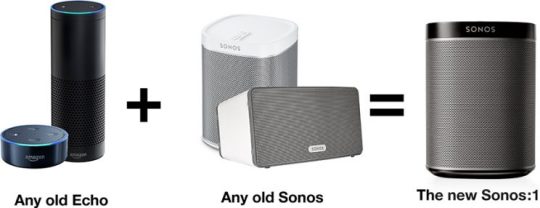
If you already have an Echo and an old Sonos, you don’t have to buy anything new to get voice control of your music.
In other words, you don’t have to buy anything new from Sonos to get voice control over an existing Sonsos setup. If you have an Amazon Echo (or if you buy an Echo Dot this Black Friday for $30 or $40)—you can enter the same musical heaven.
You’ll probably have the same critique I do: The software setup has too many steps, with too little guidance. But you’ll muddle through.
A thrilling next few weeks
Voice-controlled speakers are a hot new item this year. It’s a great idea for a tech product (have I mentioned how great it is to own one?), and lots and lots of people will be buying them.
In December, Apple (AAPL) and Google (GOOG, GOOGL) will each enter the marketplace with bigger, badder, much more expensive voice-controlled speakers of their own. There’ll be the Apple HomePod ($350) and the Google Home Max ($400).
In other words, Sonos’ window of being The One and Only is fairly short. Soon, it will be surrounded by competitors.
Sonos enjoys the freedom, though, of being beholden to no particular ecosystem. If you buy an Apple HomePod, you’ll use “Hey Siri” commands to operate it; it’s great, if you belong to the Apple Army. If you buy a Google Home Max, you’ll use “Hey Google” commands; great, if you belong to the Android Army.
But after an update coming in the new year, the Sonos One will be able to respond either to “Alexa” commands or to “OK Google” commands—a feat I’ve never seen in a single piece of hardware.
(Speaking of updates: At this moment, there’s one important music service you can’t control by voice on the Sonos One—Spotify. The company says that’ll come within the next few weeks.)
The bottom line, though, is that the Sonos One (and the free “skill” for older Sonoses) is the harbinger of a glorious new era. Most people are fairly “meh” about most smart-home products—you don’t see internet-connected light bulbs, door locks, or electric drapes in many people’s houses. But voice-controlled music? That’s got mass appeal. That’s true joy. Mark my words: It’s going to become a thing. A really wonderful thing.
More from David Pogue:
Battle of the 4K streaming boxes: Apple, Google, Amazon, and Roku
iPhone X review: Gorgeous, pricey, and worth it
Inside the Amazon company that’s even bigger than Amazon
The $50 Google Home Mini vs. the $50 Amazon Echo Dot — who wins?
The Fitbit Ionic doesn’t quite deserve the term ‘smartwatch’
Augmented reality? Pogue checks out 7 of the first iPhone AR apps
David Pogue, tech columnist for Yahoo Finance, is the author of “iPhone: The Missing Manual.” He welcomes nontoxic comments in the comments section below. On the web, he’s davidpogue.com. On Twitter, he’s @pogue. On email, he’s [email protected]. You can read all his articles here, or you can sign up to get his columns by email.
#tech#_uuid:4a2b8db6-b3bf-3436-9461-f199e005636e#Pogue#David Pogue#_lmsid:a077000000BAh3wAAD#$GOOGL#_revsp:yahoofinance.com#$GOOG#$AAPL#_author:David Pogue#$AMZN
5 notes
·
View notes